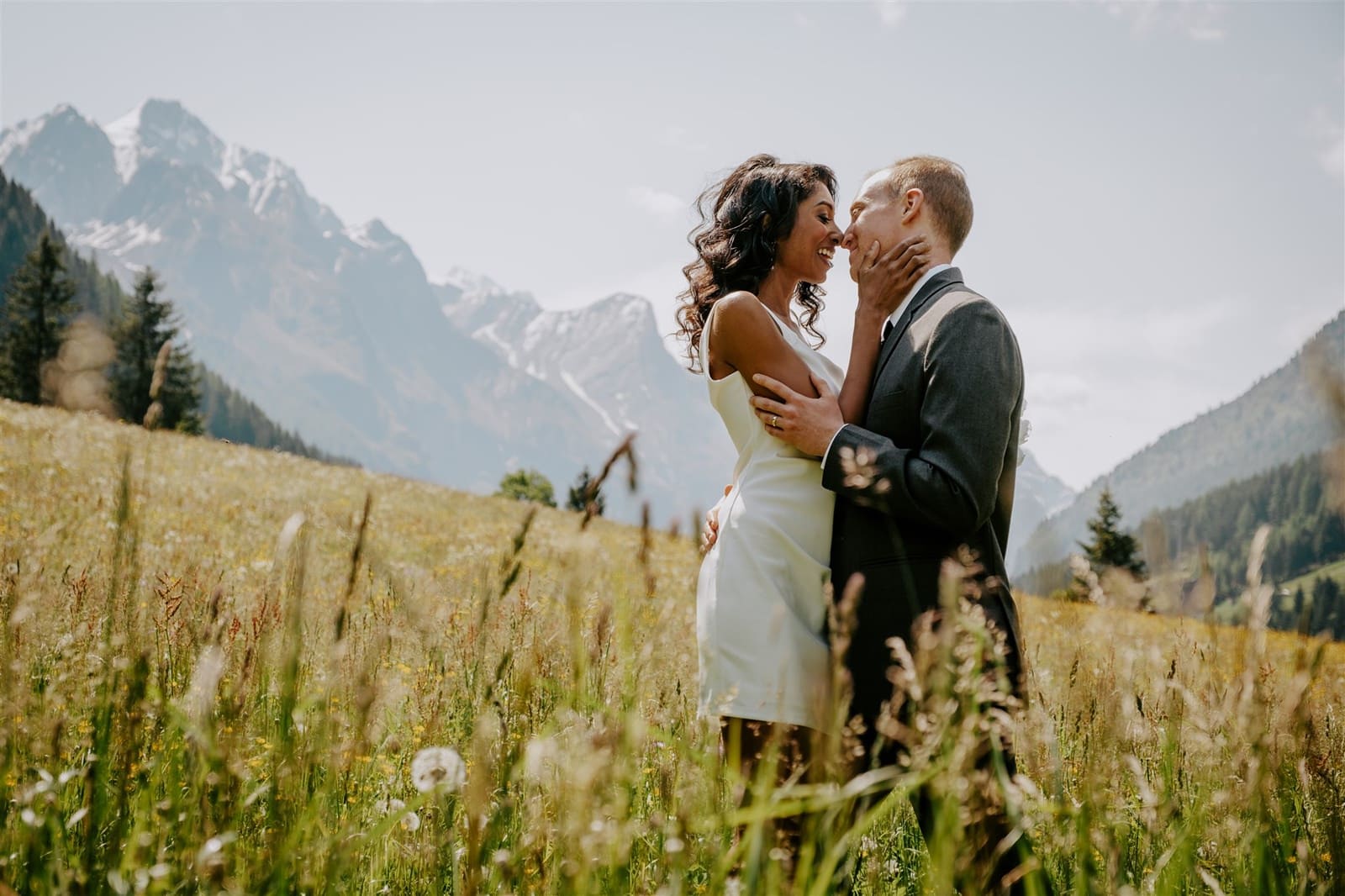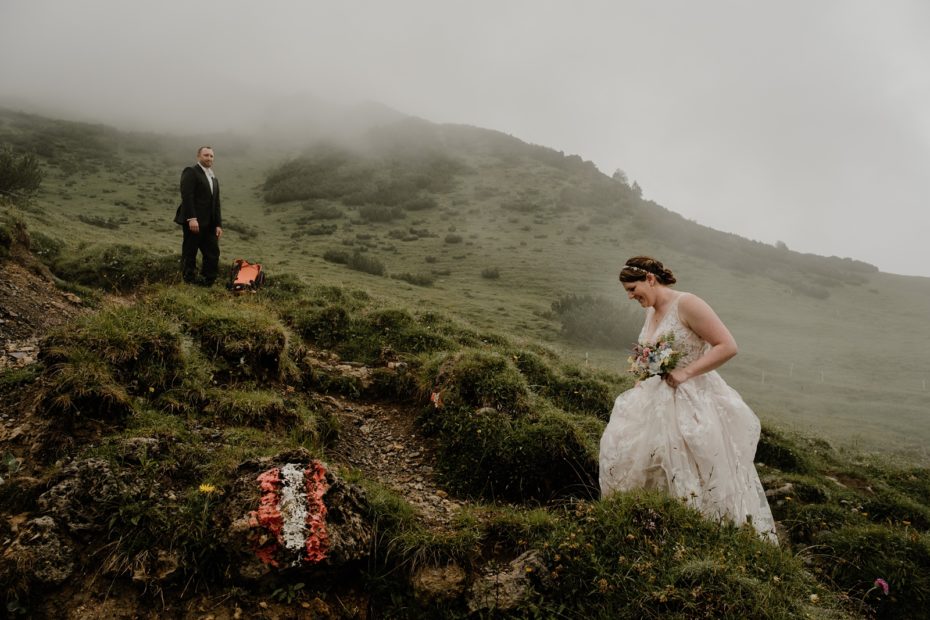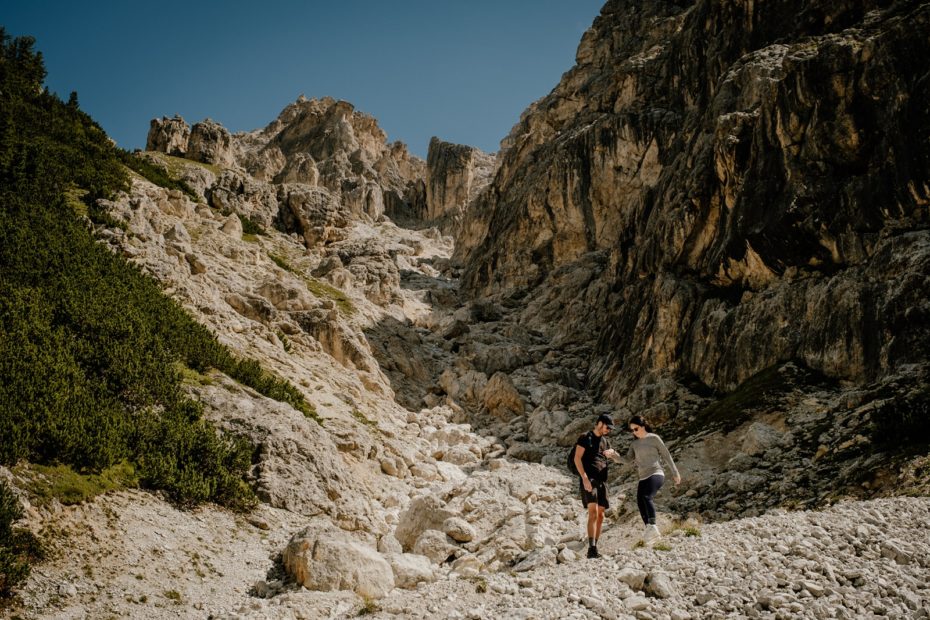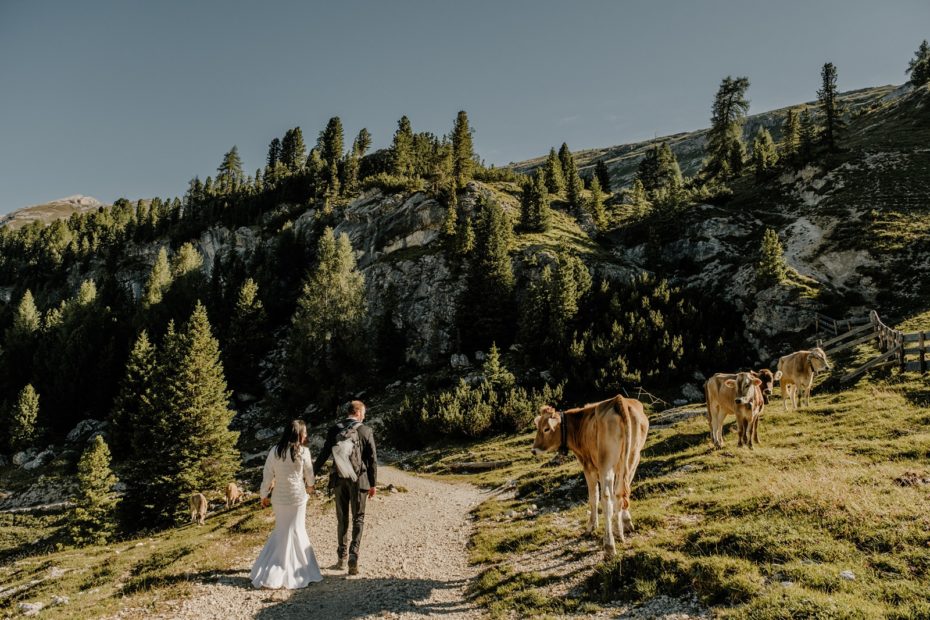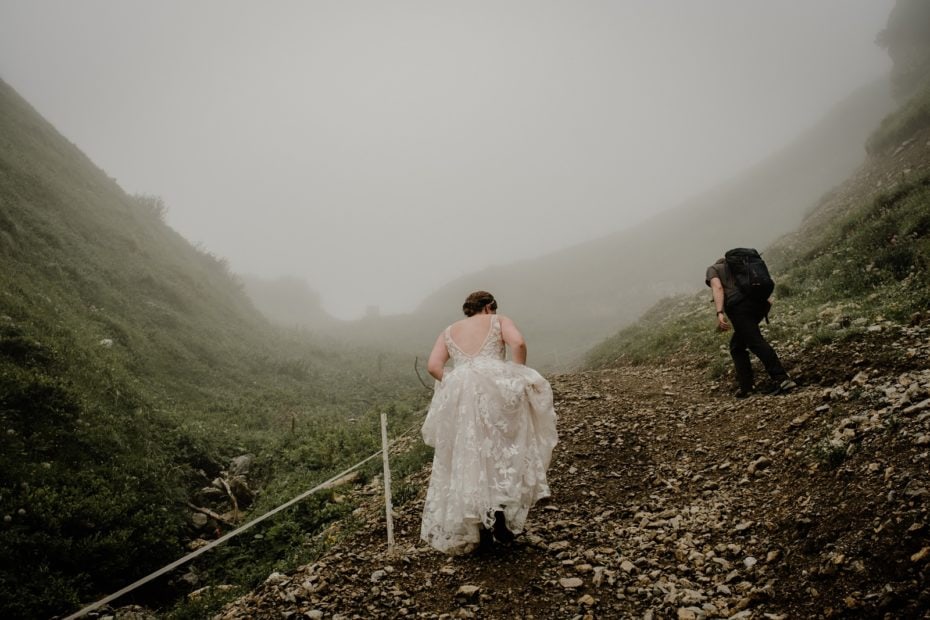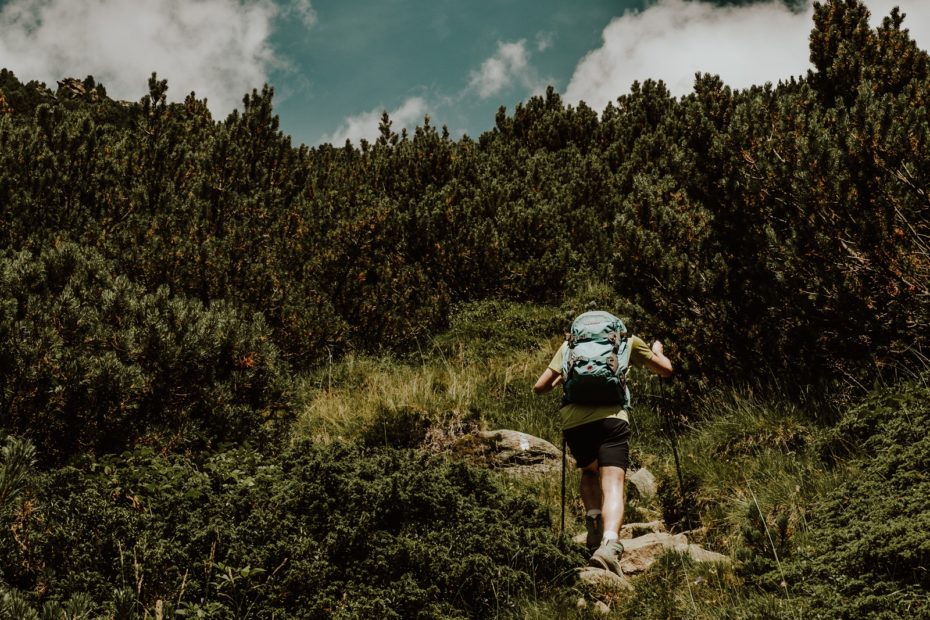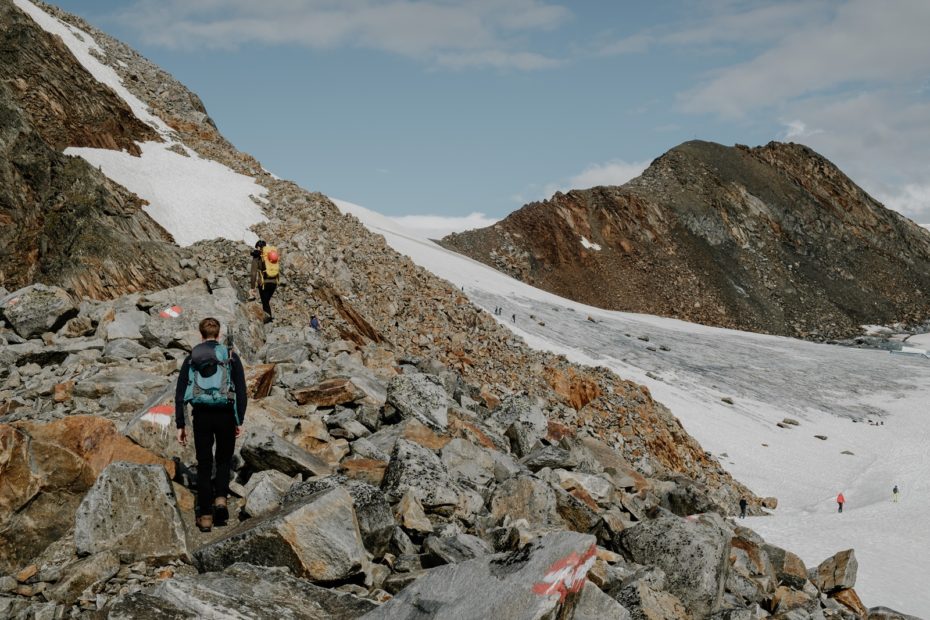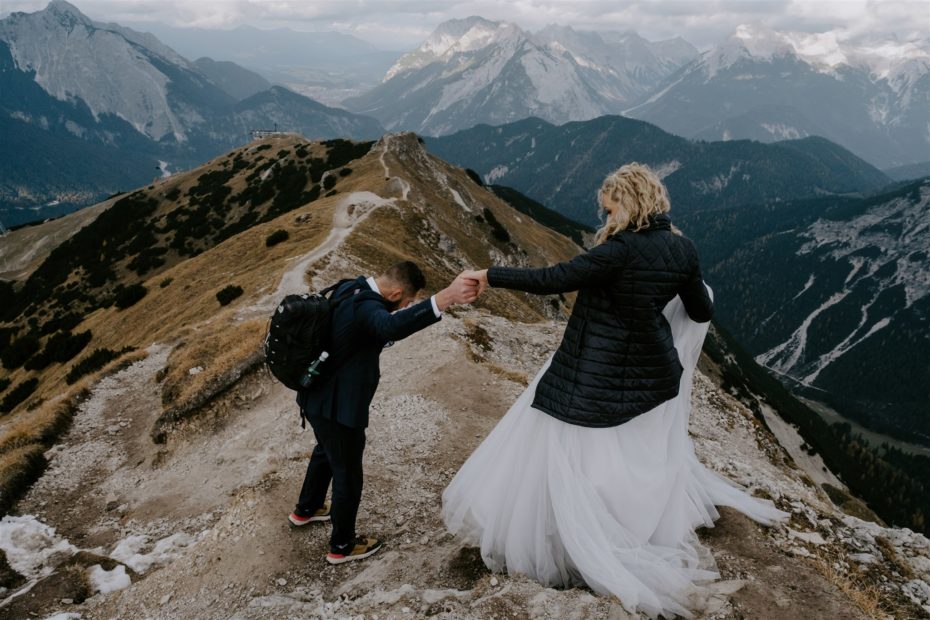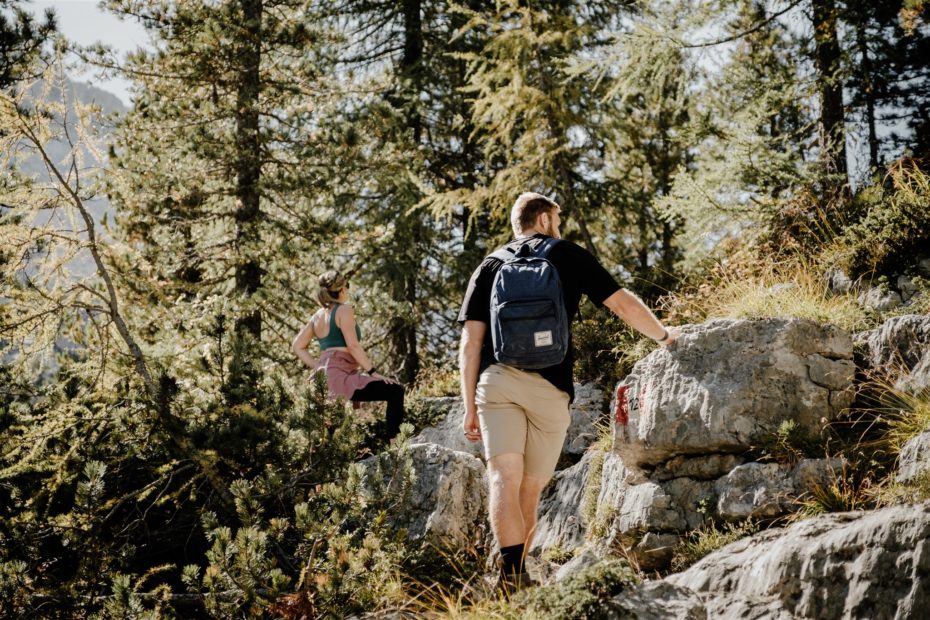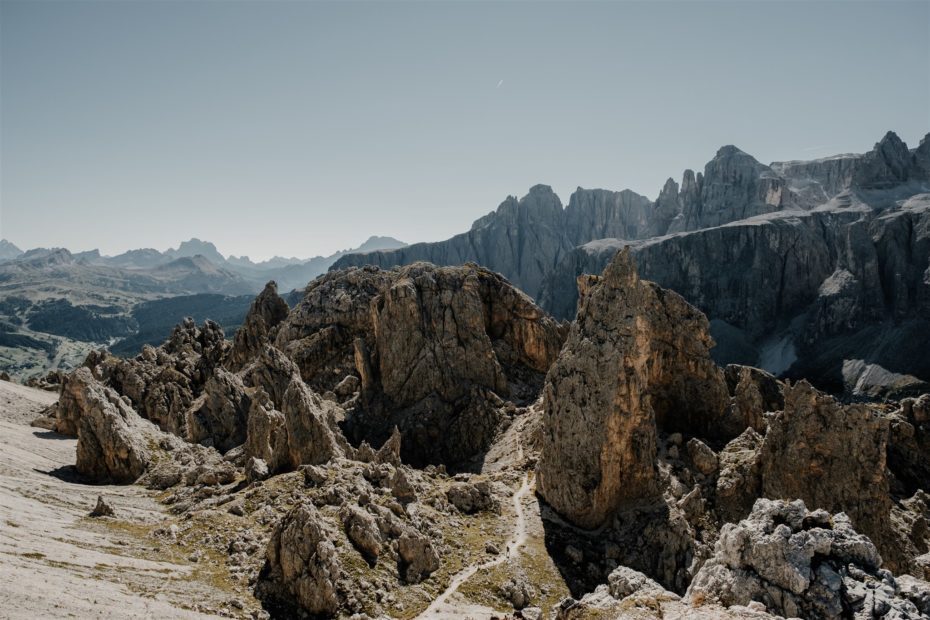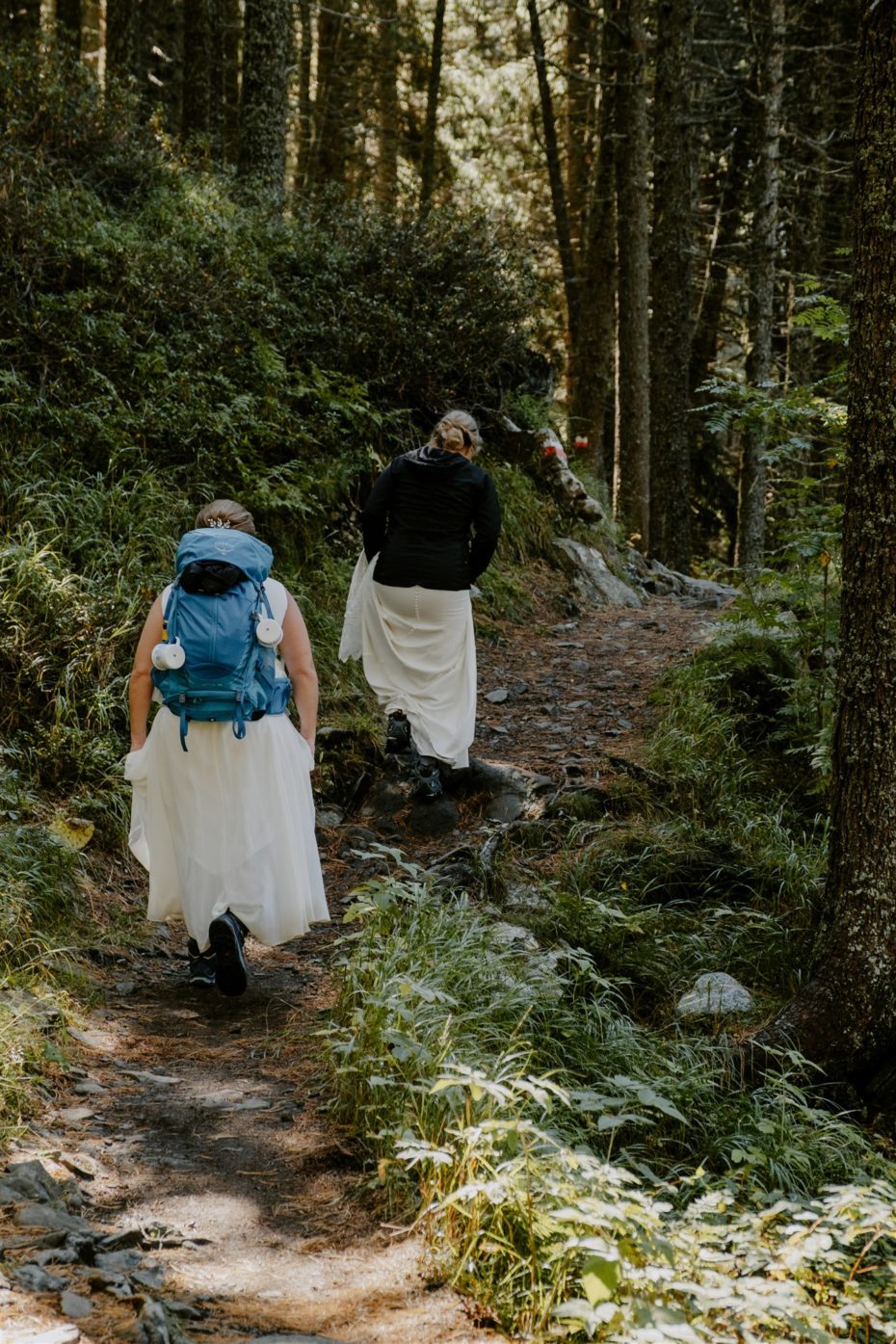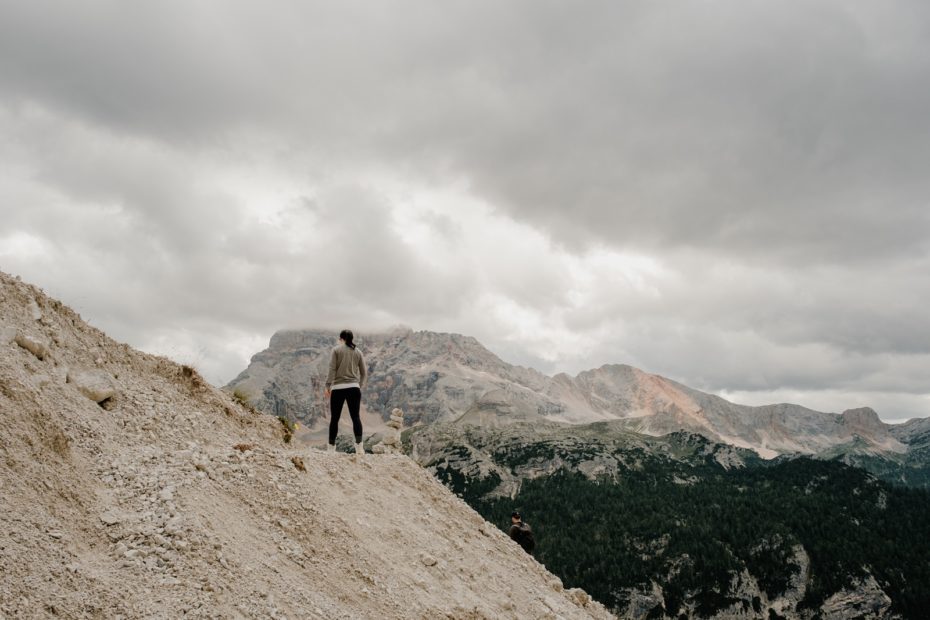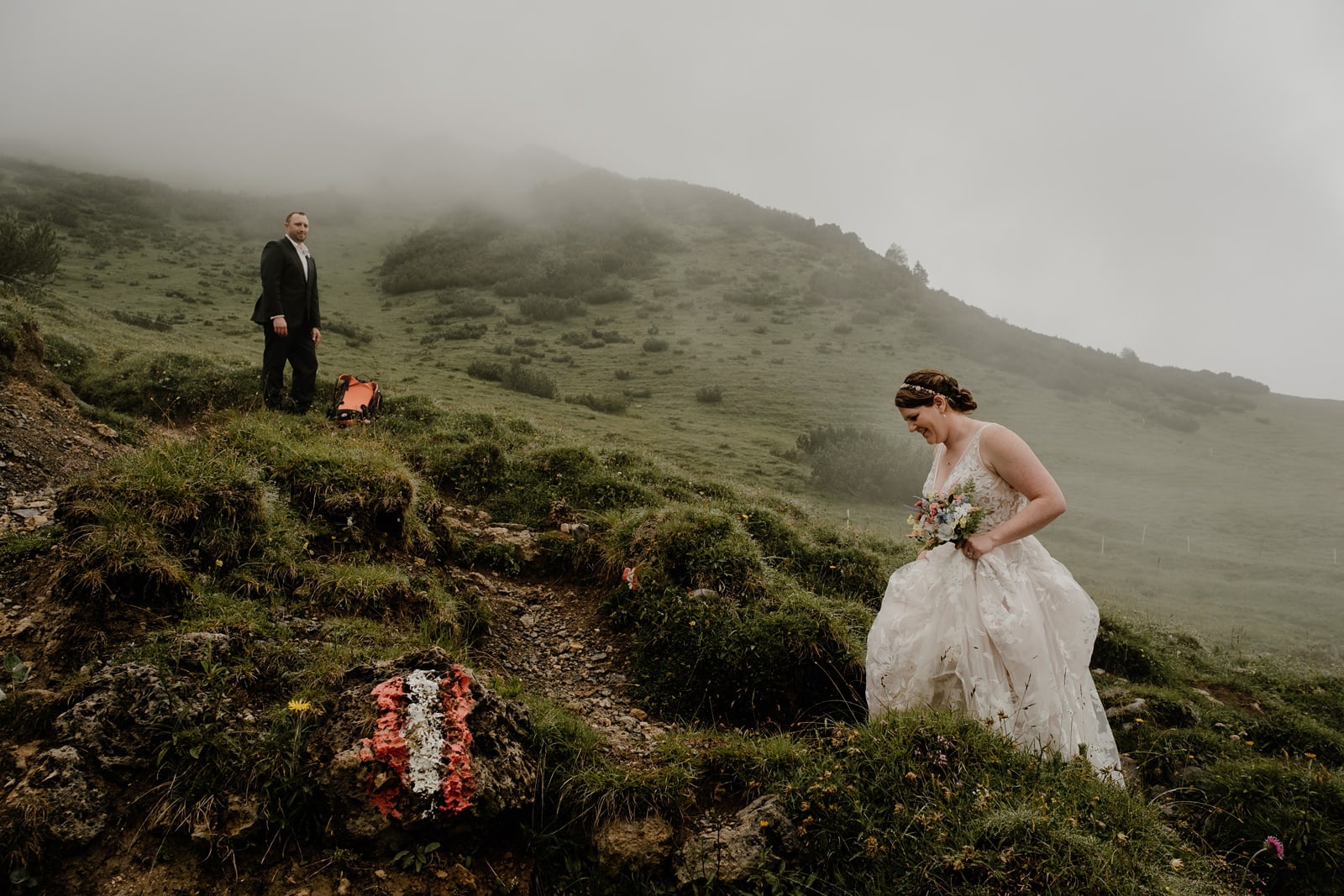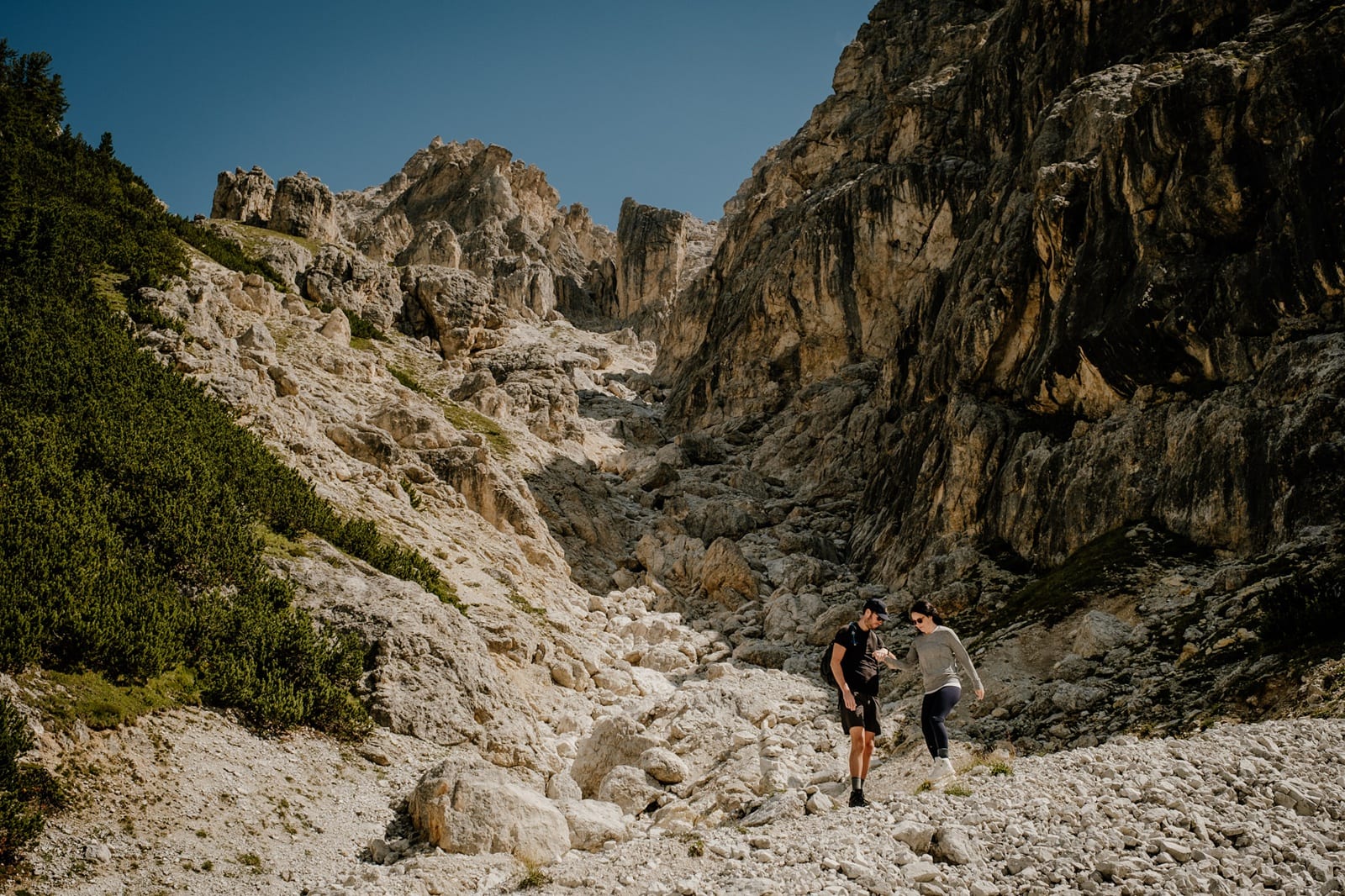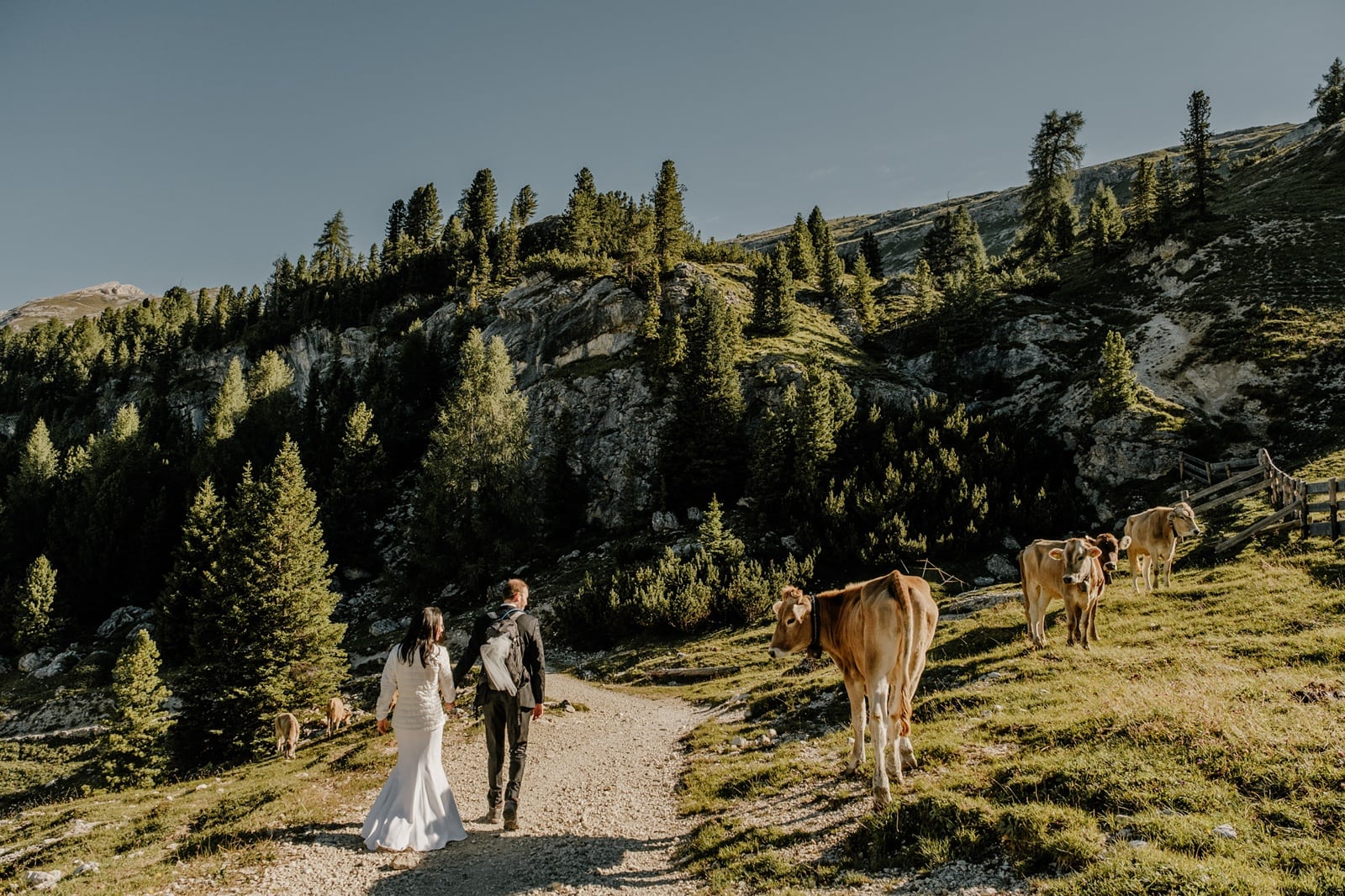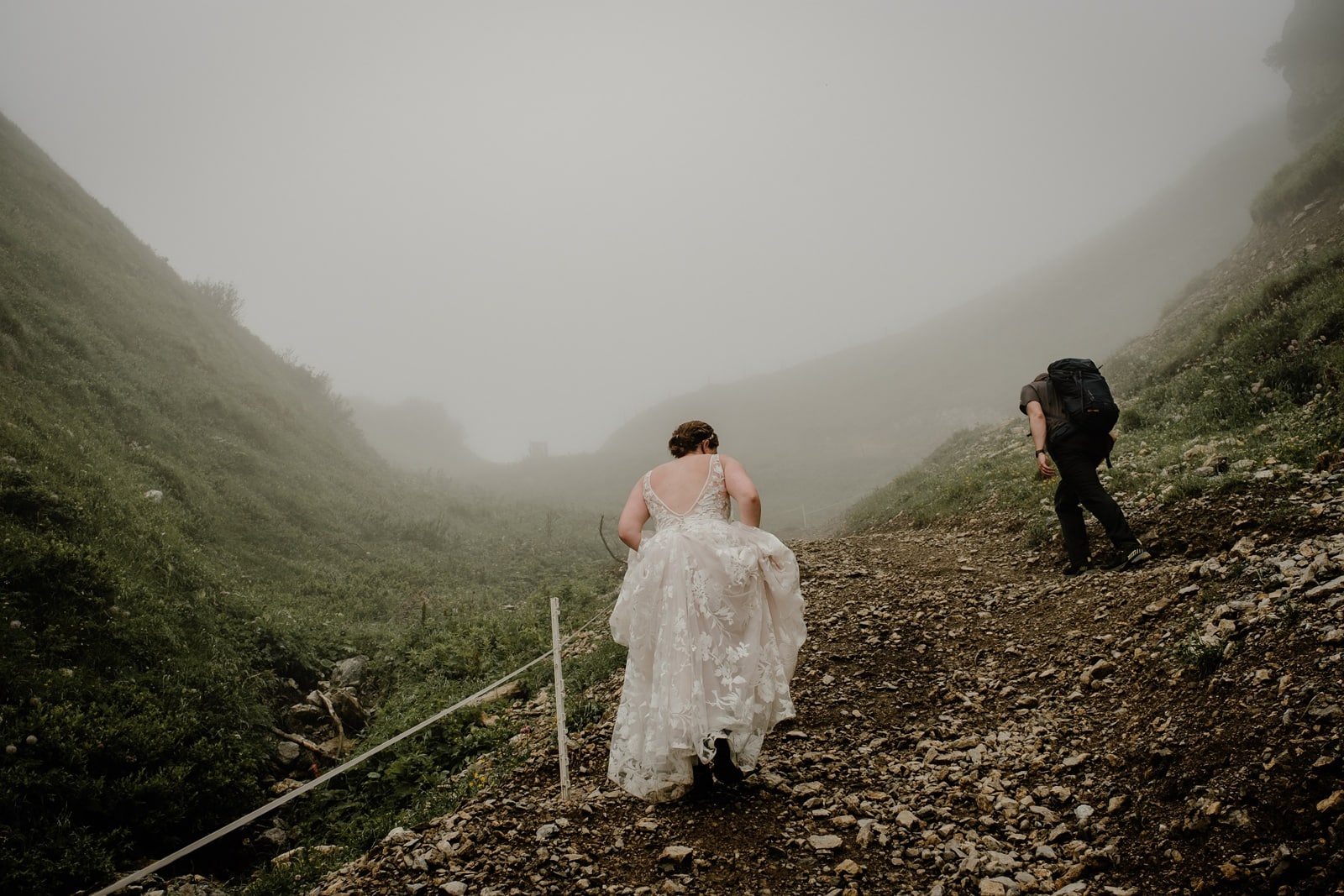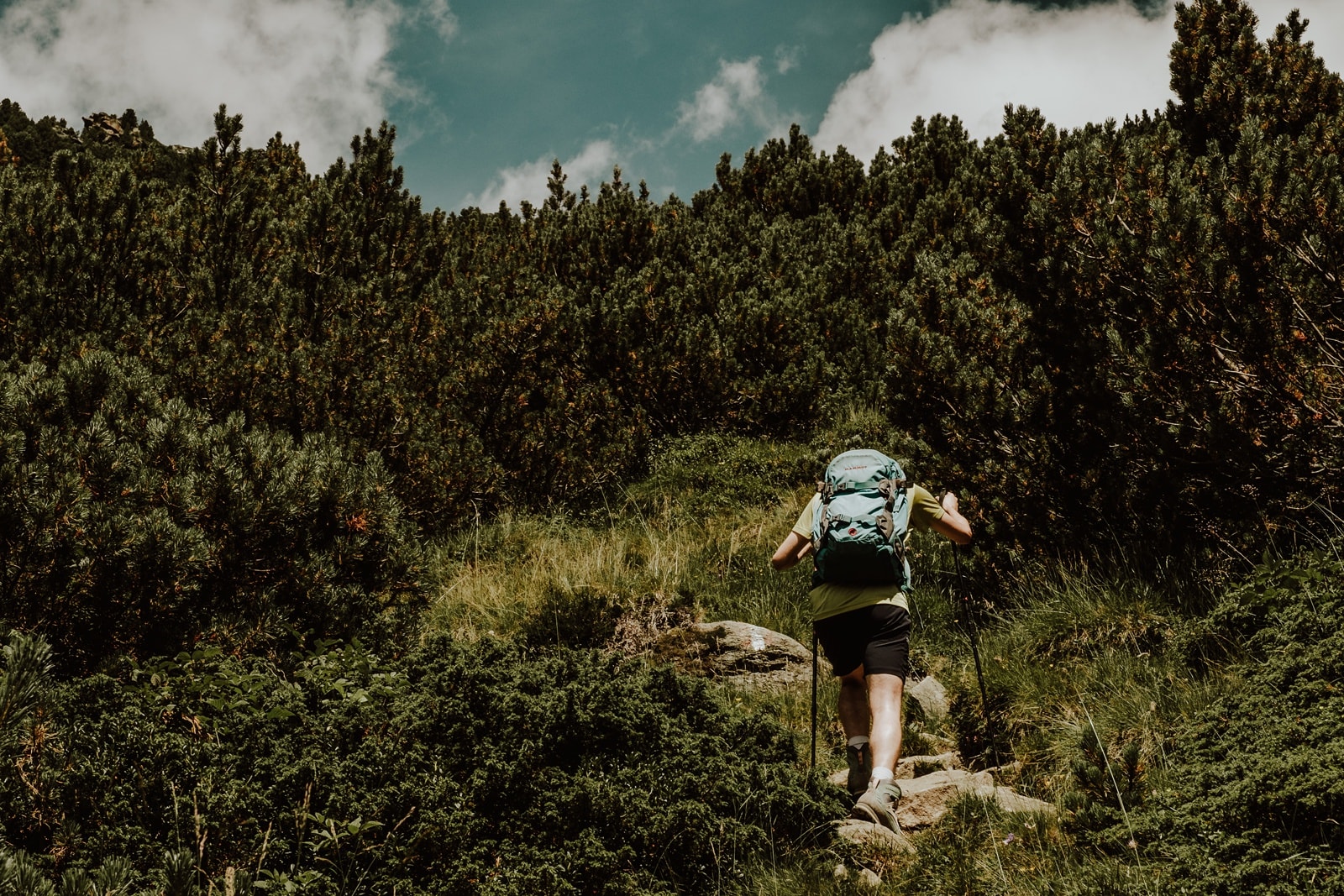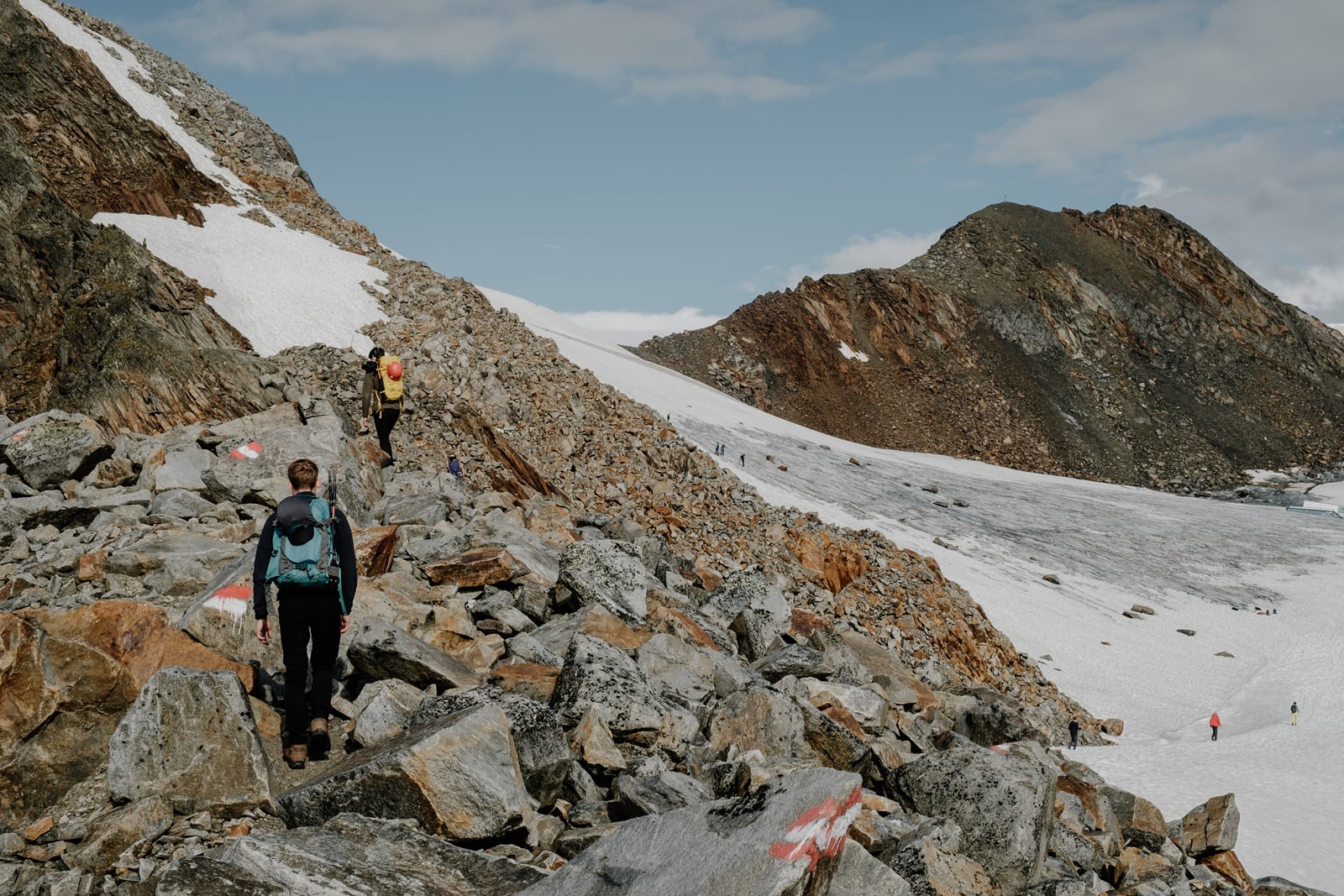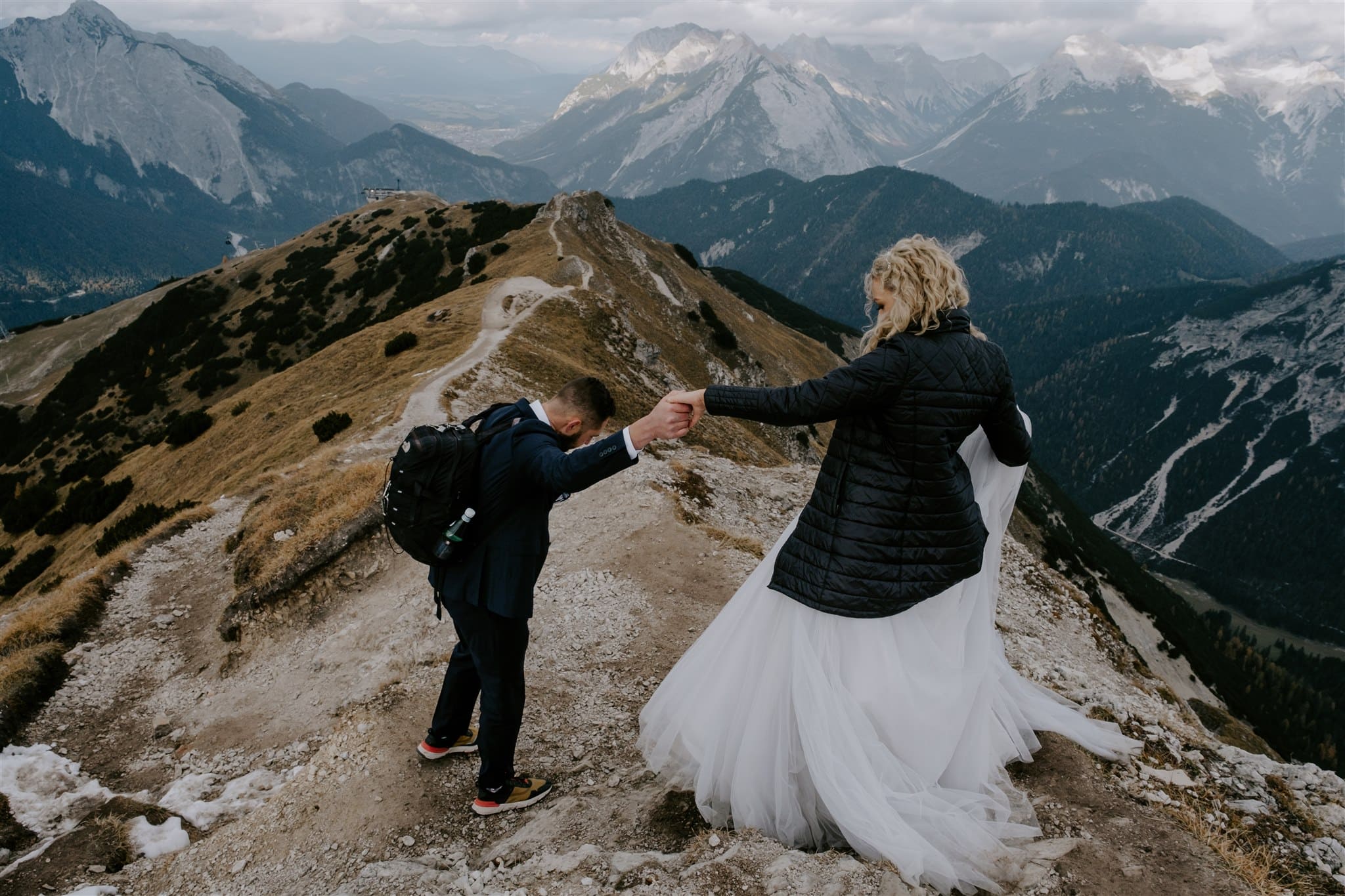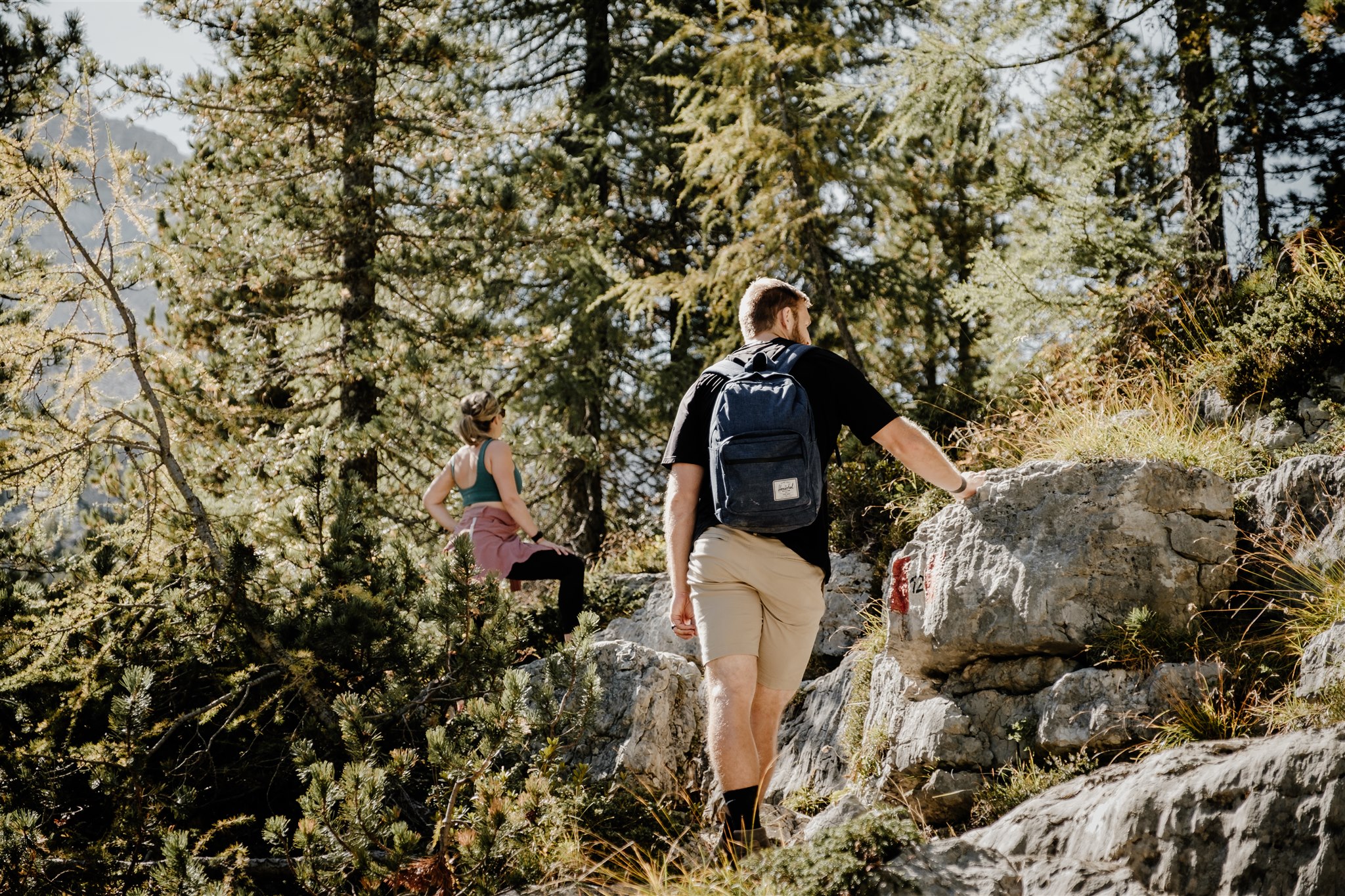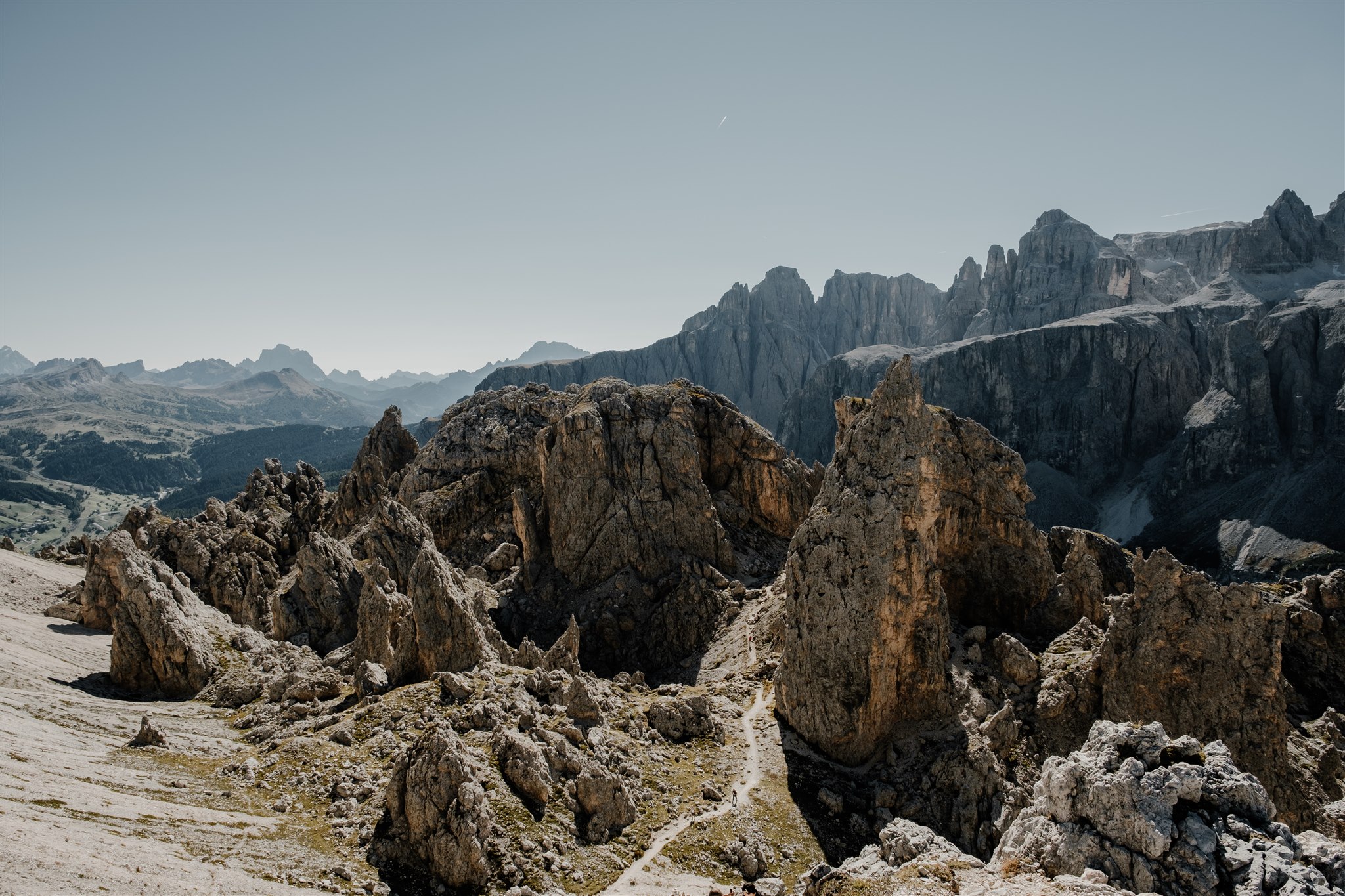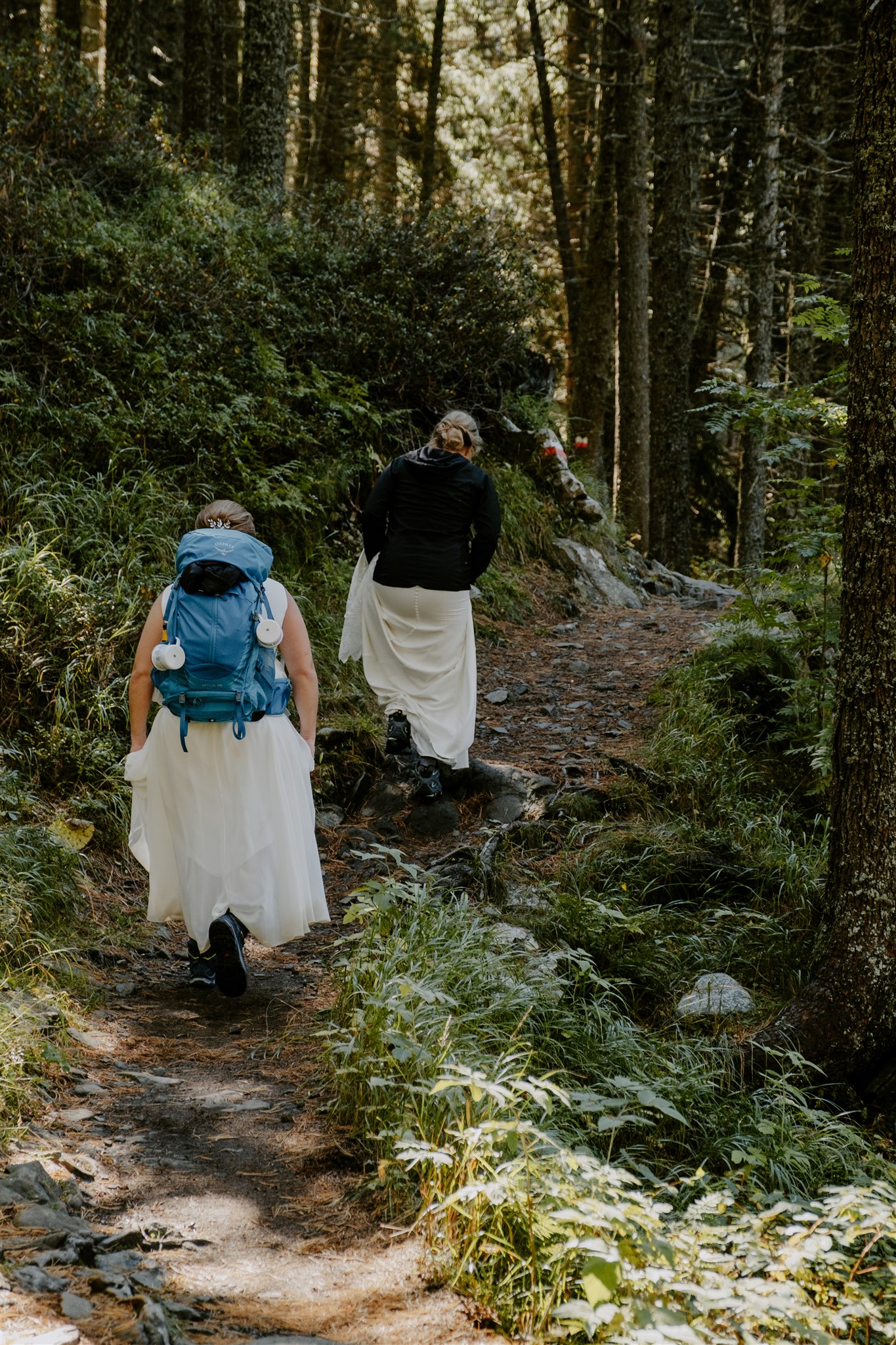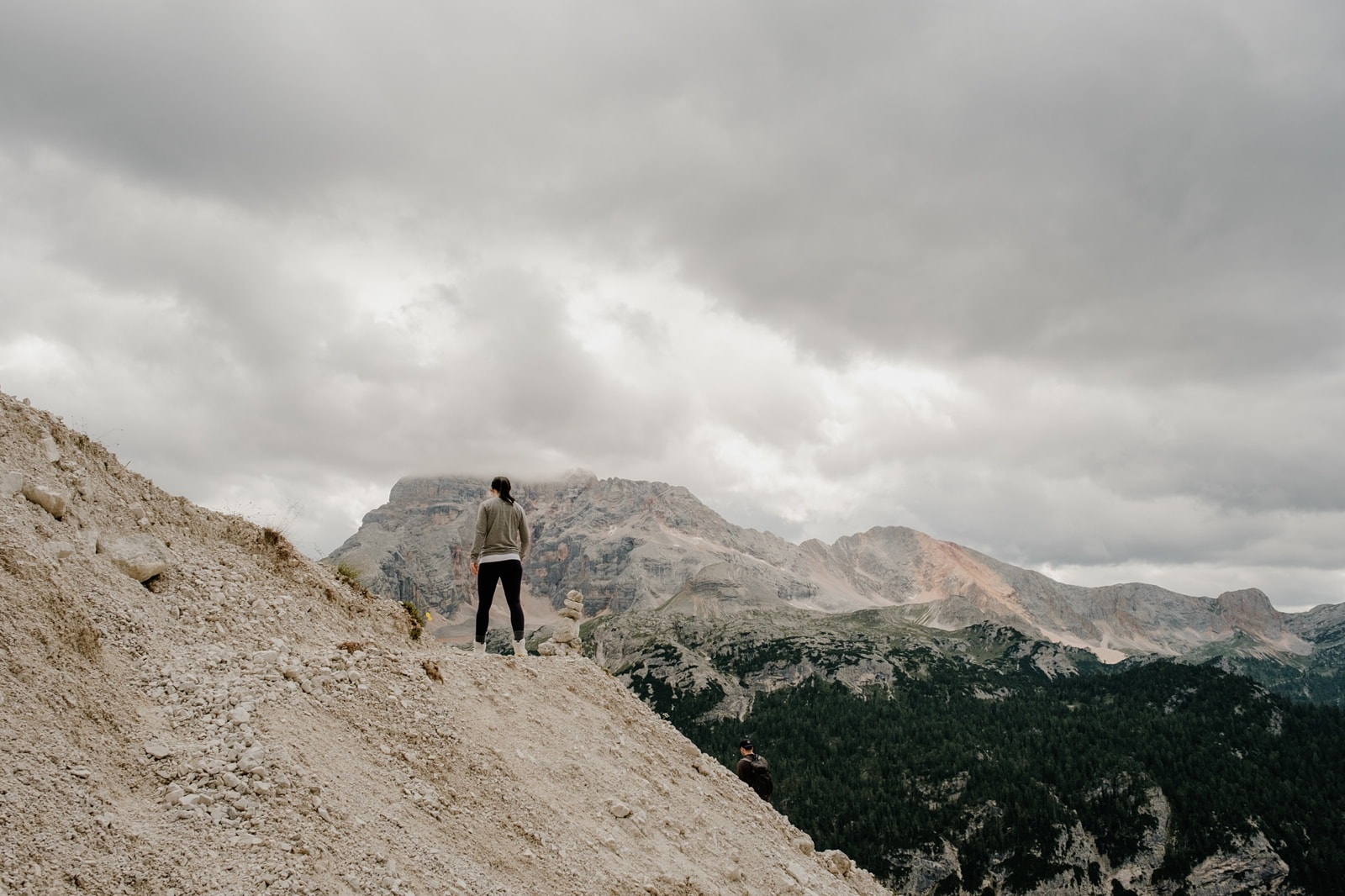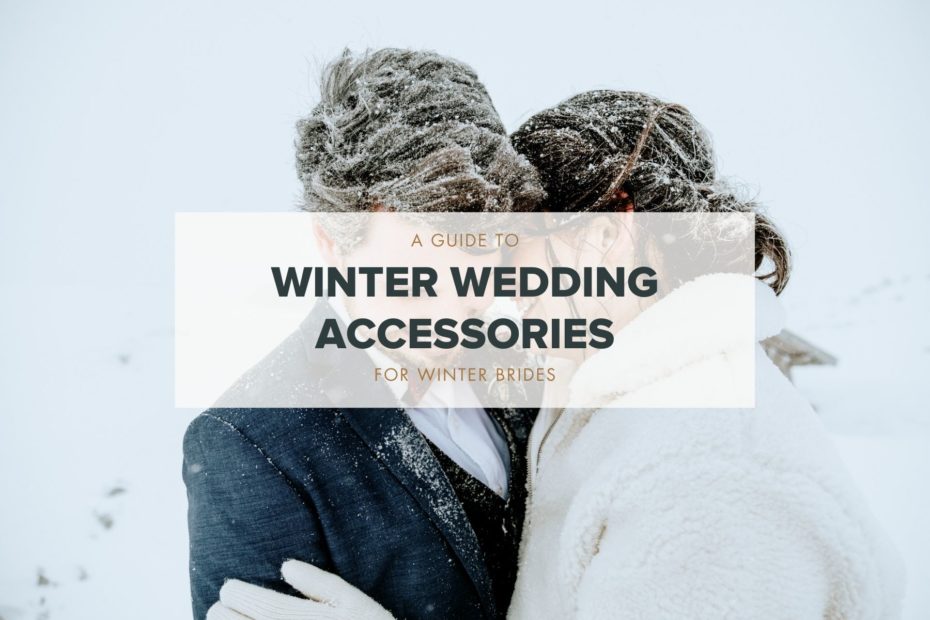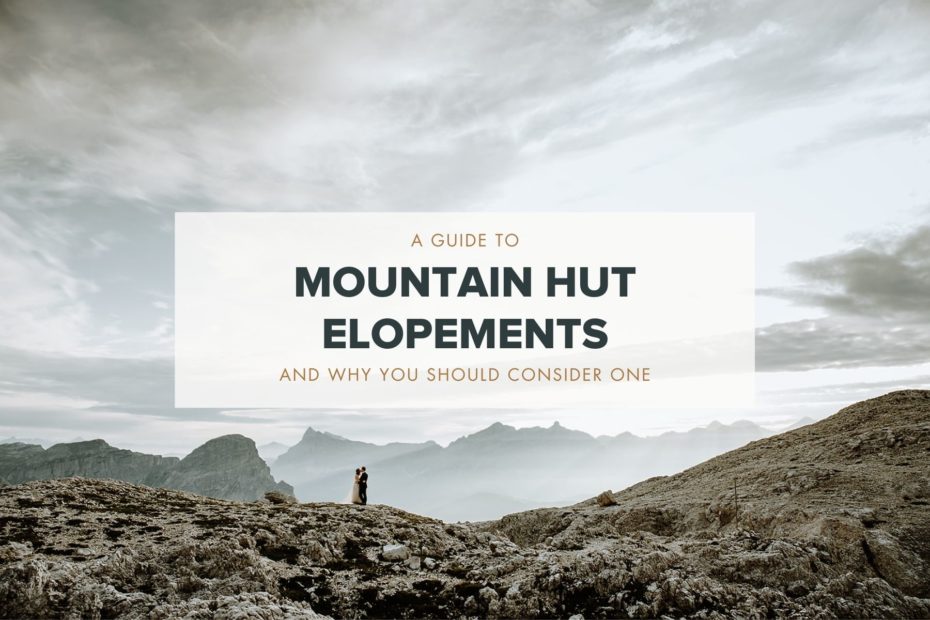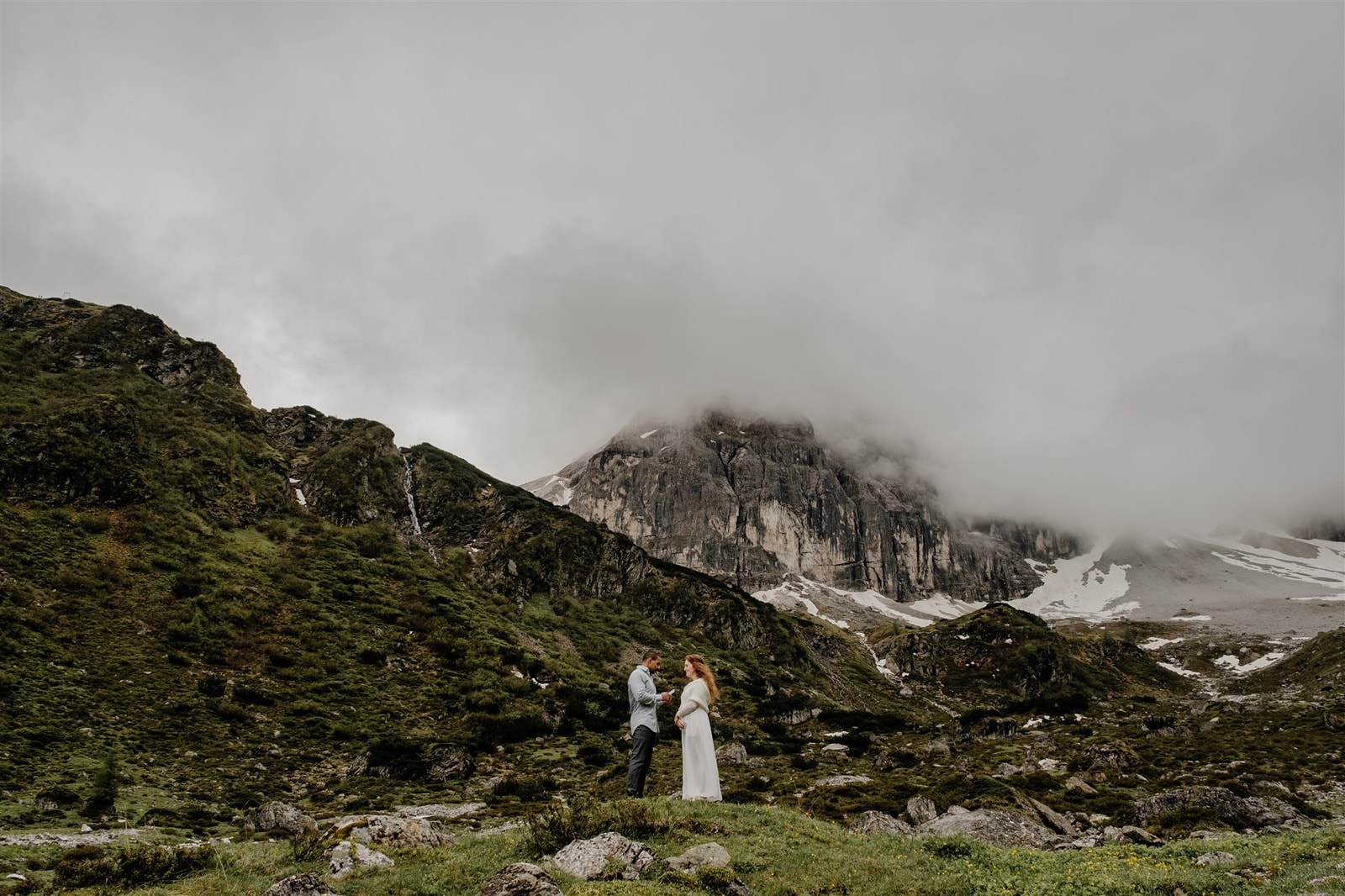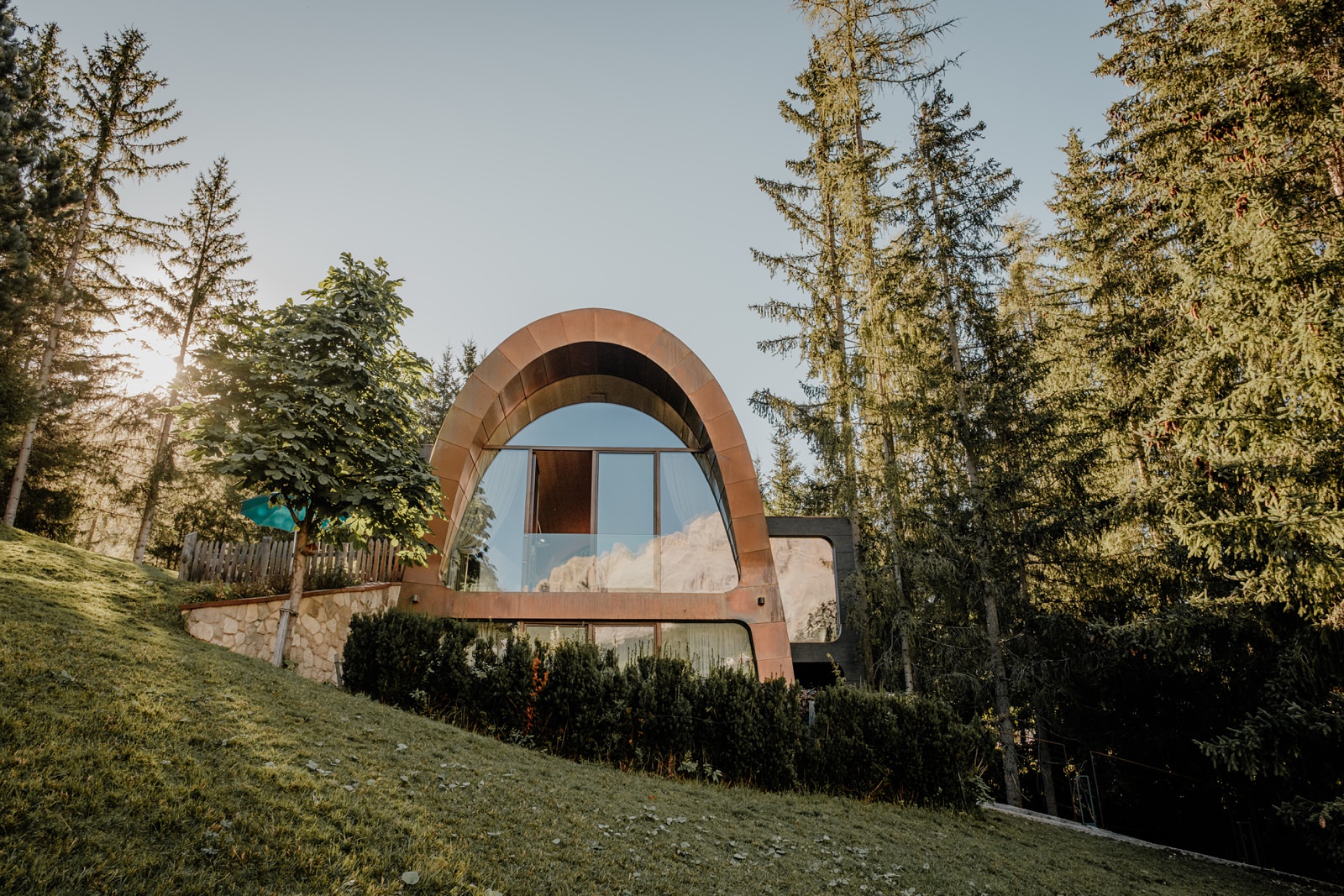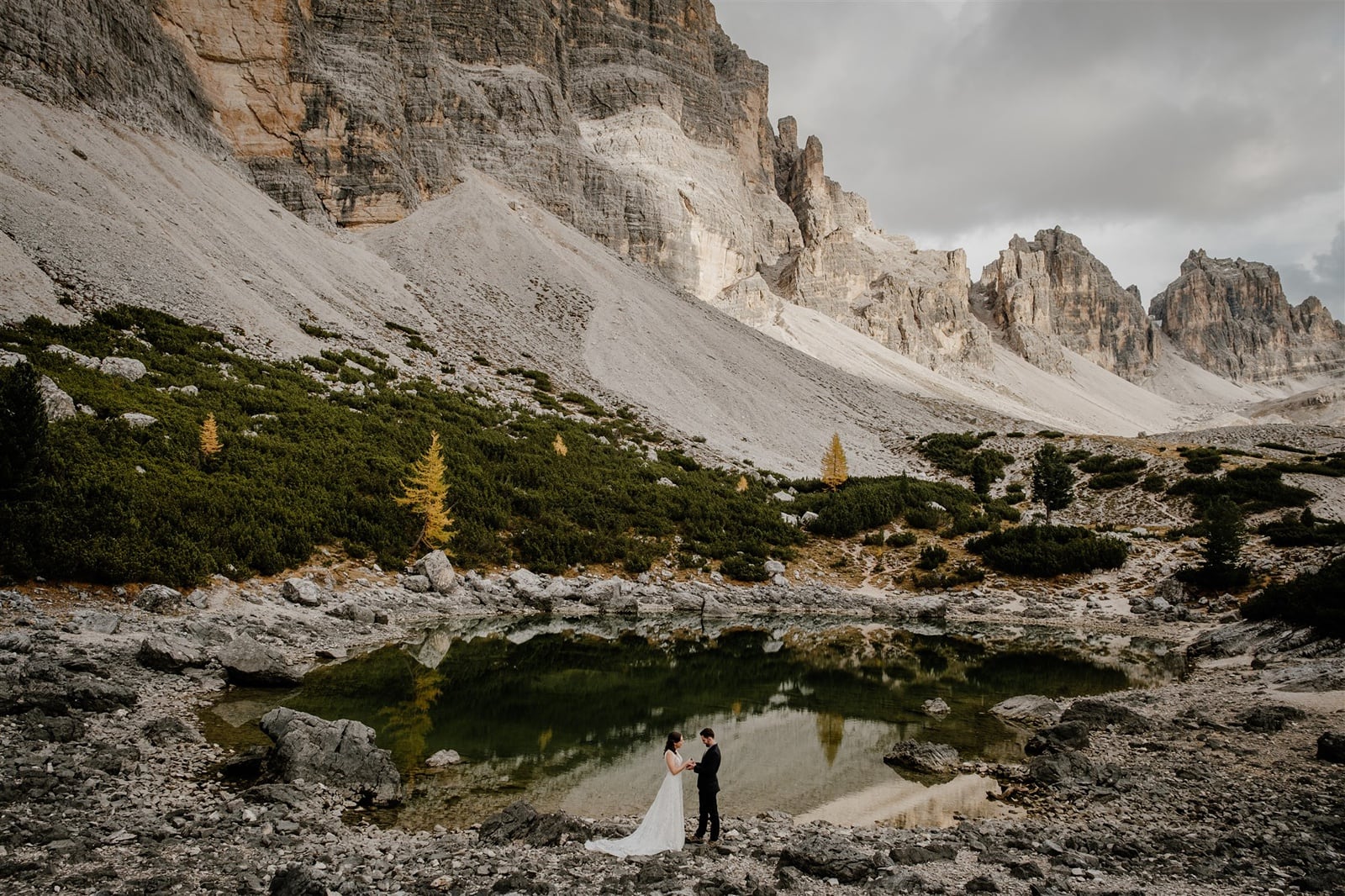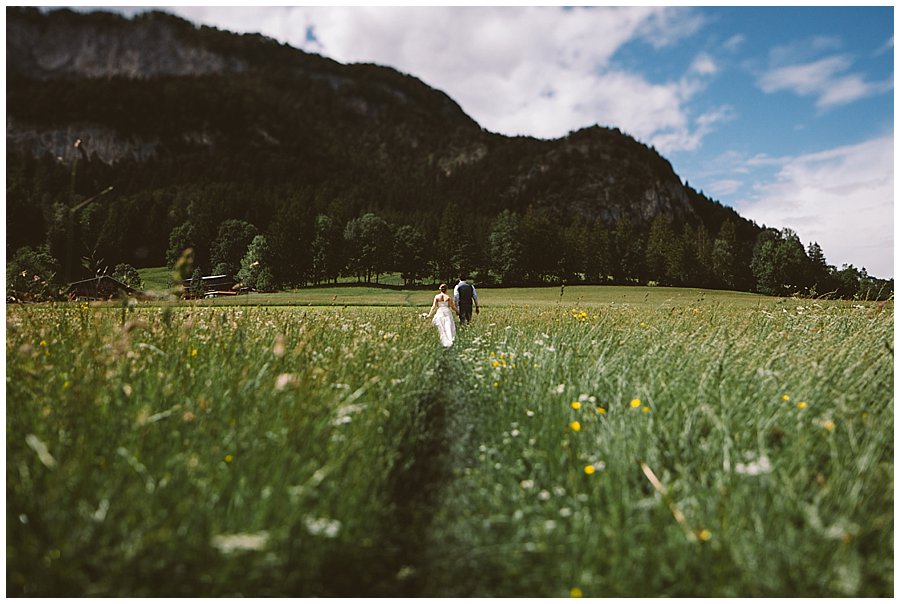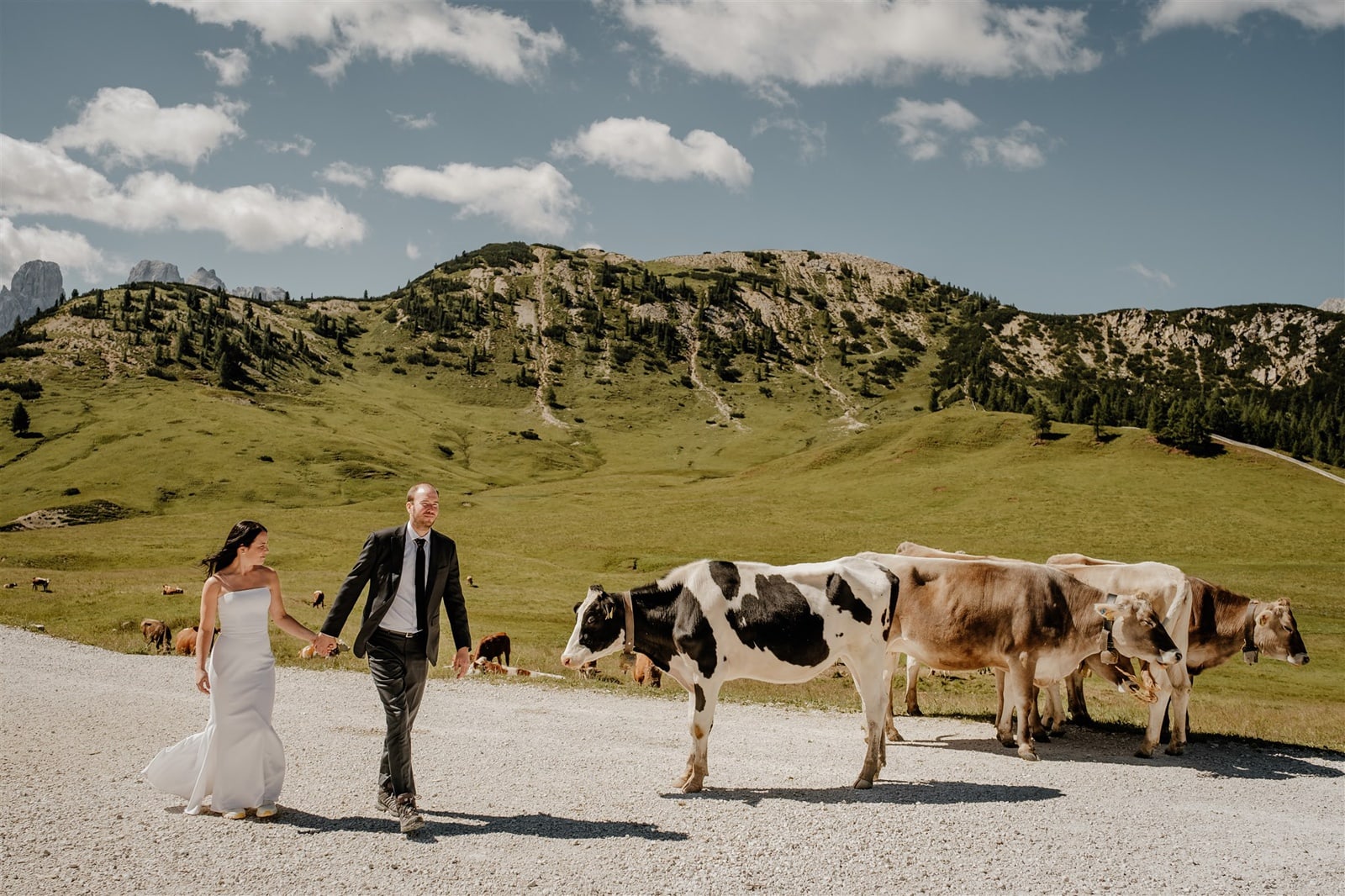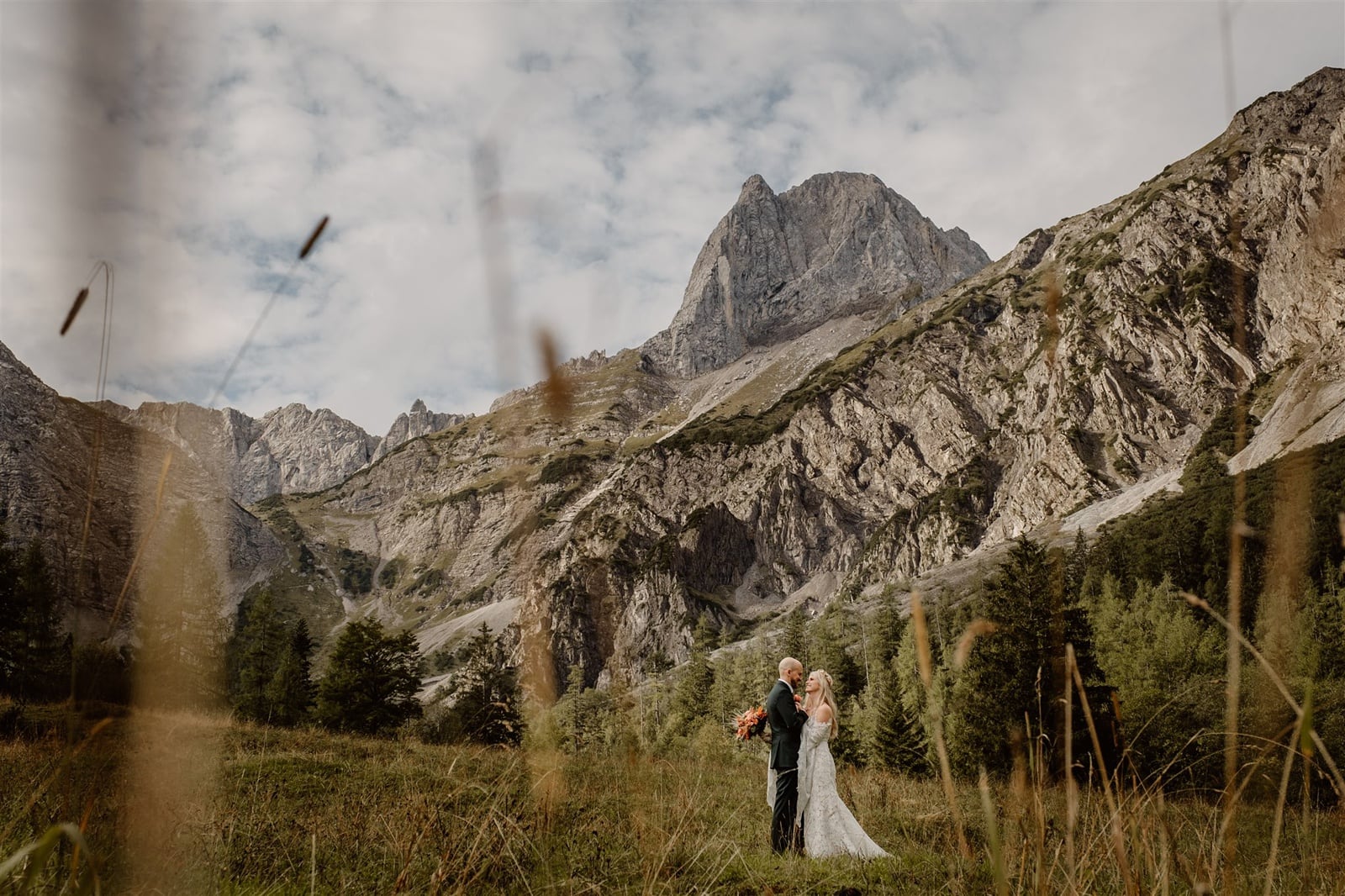How To Prepare For Your Adventure Elopement
Disclaimer - Some posts on this website contain affiliate links. I may earn a small commission at no extra cost to you if you make a purchase using my links, which I'll almost certainly use to buy more skis and climbing gear.
Even though so many of the couples that I work with are pretty adventurous and outdoorsy, there can sometimes be some confusion when it comes to planning their elopement day about what to pack and how to prepare for the adventure. You see, preparing for an adventure elopement has more similarities with preparing for an epic adventure trip (because that’s often what it is) than preparing for a wedding. Sure, there are some wedding-related things to consider, but because the adventure aspect of the day plays such a large role, and because that’s where things can quickly turn from type 1 to type 3 fun (learn about the fun scale here), that’s where the most planning also needs to be done.
In this post, I want to walk you through everything, from the blindingly obvious (but often overlooked) to the perhaps not-so-obvious aspects that you will need to consider when you prepare for your adventure elopement.
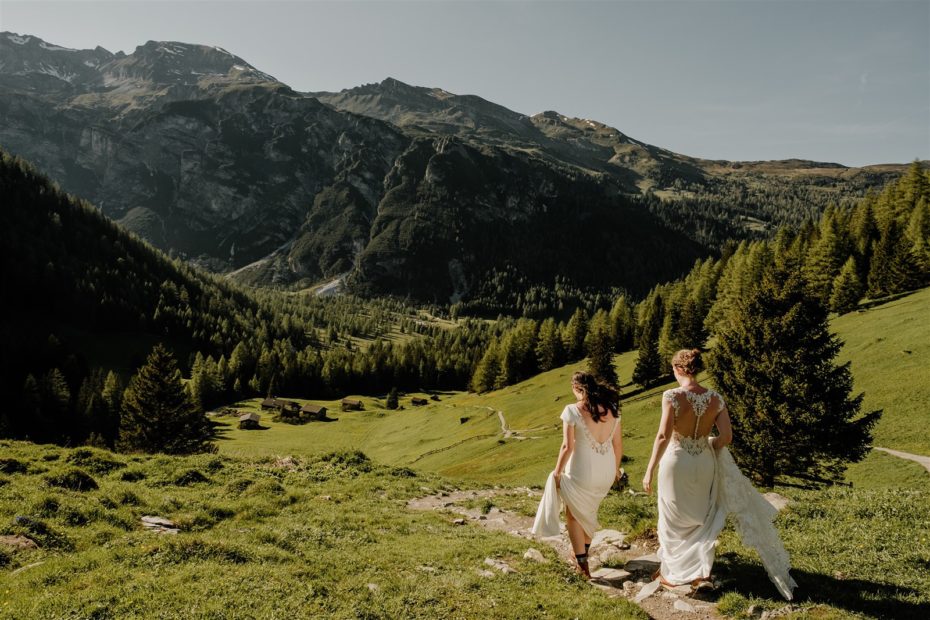
The Planning Stages
Picking Your Location
Some couples come to me after seeing a single image of mine, or an image of a location on Instagram and want to have the same, or something similar as part of their elopement too. As part of working with me as your elopement photographer and hiking guide, I’ll be the one helping you choose the most epic location for your adventure elopement (along with your planner too if you’re using one). But when it comes to selecting the location & route, there are going to be a lot of factors that will come into consideration, such as:
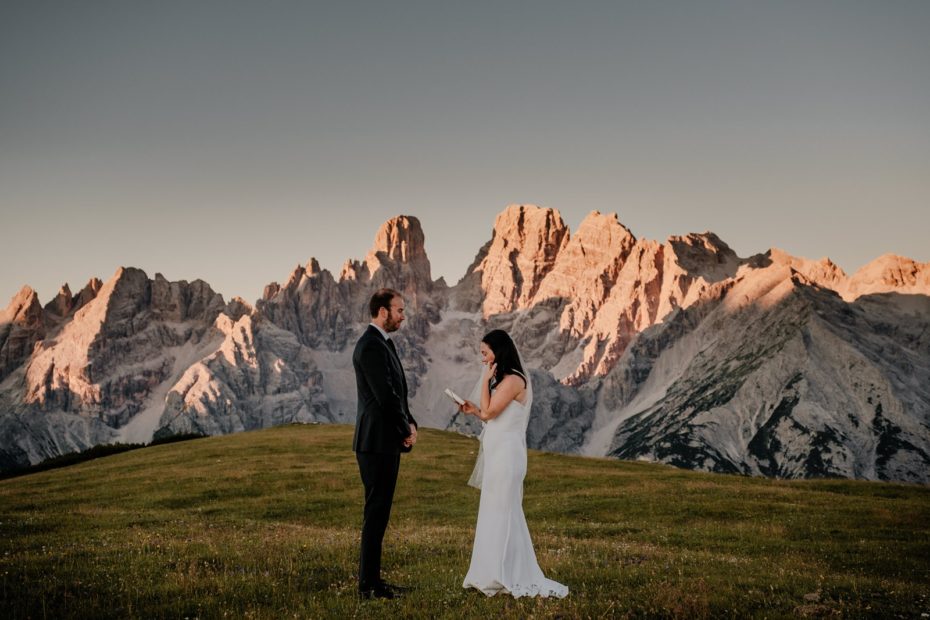
- Your Physical Fitness
What distances and altitudes are you comfortable hiking already? And in what terrain? Sure, you might be happily hiking 10 miles at a weekend, but are you also climbing up mountains, hiking at higher altitudes or over rocky and uneven terrain regularly? Lots of people seem to be surprised when they come to the Alps that the hikes seem to go steep uphill and down, and they weren’t really prepared for that (I’ll talk more about this below). Because there’s a big difference between hiking 10 miles on the flat and 10 miles up and down on steep rocky terrain. Your elopement isn’t the time to step outside of your comfort zone. Generally it’s best to stay well within it. And if you know that you’re not used to hiking up mountains but you want to give it a go, doing some extra fitness training for it before you come. - Time of Year
The weather in the mountains can be hard to predict at the best of times, but there are some seasons that are particularly hard to plan around. For example, until mid June there can still be a lot of snow around, leaving many hiking trails inaccessible. That means if you want those high-up views from a mountain top and you’re hoping for a hiking elopement, it’s better to wait until after mid-June. However, July & August are often too hot for hiking, combined with the extremely busy European summer holidays, so it can be best waiting until September or even October unless you’re willing to head to areas that are less well known and hike that extra bit further. Also if you want to be high up, but don’t want to hike, consider that mountain lifts generally run from Christmas until Easter for ski season and late May until mid September for hiking season. And don’t overlook the fact that any location that is accessible by lift is going to be much busier simply due to its ease of access. The reality is, the easier a location is to get to, the busier it will be. While your date might be already be set, it’s important to be realistic about what’s accessible at this time. - Sunrise & Sunset
Us photographers loooove sunrise & sunset (and the aptly named “golden hour”). Light at these times of day can be really gorgeous. BUT sunrise and sunset in the mountains aren’t as straightforward as when you are somewhere with a relatively low and flat horizon. I often have couples requesting a sunrise or sunset ceremony, without understanding what that may actually mean for a particular location. Sunrise & sunset can be gorgeous if you are high up in the mountains where you have a horizon. But if you are down in a valley, or surrounded by very tall mountains, you may find that while sunrise happens at 5:30am, your location actually could be in the shade until 8am due to the surrounding peaks, and that it doesn’t look quite how you pictured it. Sunrise & sunset can also prove to be quite logistically challenging when it comes to the timeline of the day. Are you ok with a 3am start for getting ready to catch the 5am sunrise that’s a 1-hour hike to get to, or skipping dinner in order to catch the 9pm sunset and hike back in the dark? (On a side note, this is why I love multi-day elopements and mountain huts, because they make it so much easier). - Mountain Huts
On the topic of mountain huts, if you are still undecided about whether you want to stay in a mountain hut for your elopement then read my mountain hut guide first. Whilst I think it’s an experience you’ll always remember, not everyone wants their elopement to be quite so adventurous.
-> Everything you need to know about mountain hut elopements

Hiking In The Alps – So What Should You Expect?
I probably need to start this section by saying that many people who have not hiked in the Alps before tend to find the trails here steep in comparison to hiking in places like the USA. What is considered an easy hike and what is considered challenging in terms of hiking length, terrain and difficulty can be extremely subjective at the best of times. So if you tell me they are happy with an easy to moderate hike, it’s difficult to know exactly what your definition of easy is. One person’s definition or experience of hiking can very vastly from another person’s, depending on where they are from and what they have hiked before. One of my favourite elopement spots in Tirol is what I would class as a very easy hike, but I have had some people struggle with it, since even though the hike is only short, it’s uphill all the way.
So let’s first take a look at what hiking looks like in the Alps…
In the Alps, when we talk about hiking, we are usually talking about climbing mountains. If you’re not hiking up a mountain, it’s generally considered walking (even if it’s more like cross-country trails). It’s not uncommon here for 80+ year olds and parents with small kids to easily hike over 10 miles and 2000ft in a day. That’s just our “normal”.
Types of terrain:
Hiking trails are maintained to a degree, but it’s generally accepted that when you go out hiking in the mountains, you will be in a variety of different alpine terrain, and each can come with its own challenges.
Most trails across the alps are across the following types of terrain:
- Loose gravel
- Rocky
- Grass & mud
- Forest trails with exposed tree roots
- Boulder & scree fields
When you’re looking at which location you want for your elopement, the type of terrain you’ll cover to get there may have an influence on things like:
- The speed you’ll be able to hike
- What you’ll wear – including shoe choice and whether you’ll hike in your wedding clothes or not
Elevation:
In the Alps, because there are very few hikes that are flat, we generally don’t talk about our hikes in terms of distance in miles, but instead in terms of the amount of altitude gain, since that’s usually the most important factor when choosing a hike. This goes back to my point above – you might be fine hiking 5 miles on the flat, but can you hike 5 miles when it’s 5 miles of steep uphill? Not all miles were made equal 😉
For an easy hike in the Alps, you can expect to be doing anything from 1000-2000ft of altitude gain. Anything under that is really not really hiking but more of just a walk, and you’re unlikely to be getting far from other people.
For a moderate hike, you’re looking at closer to 3000ft of altitude gain.
Distances:
Continuing on from above, while distances are important, in many cases, they are less of a deciding factor than elevation, as there are a lot of hikes that don’t cover huge distances but can cover pretty huge amounts of elevation gain in a short amount of time (hello mountains). If you only look at the miles covered, something might look like an easy hike, but if you see how much elevation you’re gaining on the uphill, that can change quickly!
If you don’t want to hike more than 1-2 miles, you need to expect that your location may not be so private. Such a short hike means the location can be easily accessed by anyone. So if that really is your maximum, then you may want to consider a sunrise or sunset when there are fewer people around (if the location allows), or a location that is a bit more obscure and unheard of (which I can help with).
When I’m sending you route proposals during the planning stages, I may send animations of the routes, like this one, so that you can visualise the terrain we’ll be covering:
Choosing Your Adventure Elopement Clothing & Gear
As a hiking guide as well as an elopement photographer, it’s my responsibility to make sure you are correctly kitted out for a day in the mountains. Your safety and enjoyment is my no.1 priority, and much of that starts with making sure you have the right gear. If you’re not suitably prepared for the route we’ve chosen, we’ll have to change plans. So preparation is key!
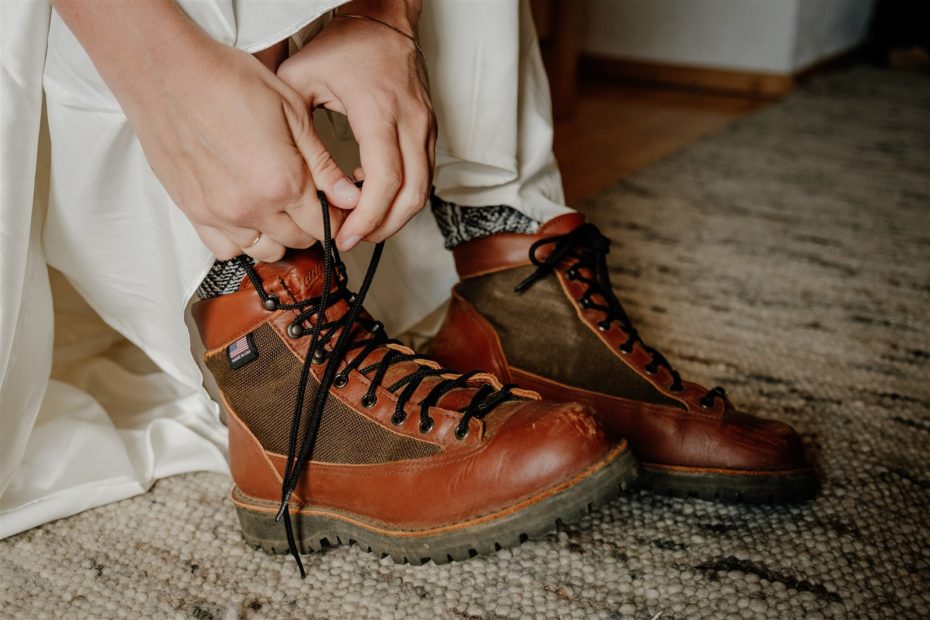
Choosing Adventure Elopement Footwear
The best possible footwear you could wear for a hiking or winter elopement… is the hiking boots you already own. You know they are comfortable, that you are able to hike in them, they will be broken-in to your feet and using the footwear you already have is better for the planet. However, there may be some circumstances where you may need new ones, such as if what you have isn’t suitable.
If you are looking to buy new shoes for your adventure wedding here are a few things I recommend when shopping:
Take the time to find well fitting boots
If you know your size and are buying the same model as you’ve always worn you’ll already know which boots you are going for. If not, I’d recommend taking the time to go into a store and try different boots on to see which feel the best on your feet. Different makes and models size slightly differently so you might find yourself sizing up or sizing down accordingly.
You’ll want to make sure that your hiking boots are a snug fit around the ankle but that they don’t feel tight, pinch or rub anywhere. At the same time, you want to have a bit of room around your toes for when you’re going downhill (your feet slide forward in the shoe when you descend and if the shoe is slightly on the smaller side you can say goodbye to your toenails). Top tip’s for trying on boots are to try them on at the end of the day – as your feet are likely to swell, and take the socks with you that you plan to hike in, so that you know the boots are the perfect size with them. A good outdoor shop will often have little ramps and steps so you can try them as if you were waking up and down a steeper slope.
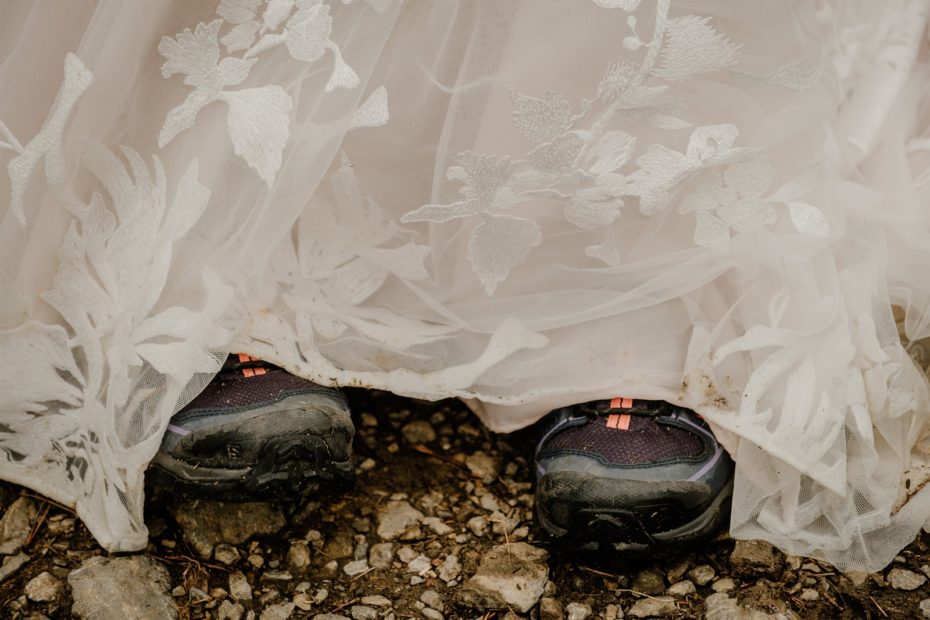
Make sure they are waterproof
Whether you have a preference for leather or Gore-Tex boots, making sure your boots are waterproof is an investment worth making. Sometimes just walking through wet grass with morning dew or crossing a stream is enough to get wet feet. And when it rains in the mountains, it really rains. No one wants wet feet on their wedding day and especially not if you are hiking for several days in a row.
Prioritise good tread
Whether you are picking boots for a summer hiking elopement or a winter elopement ensuring they have good tread is essential. The trails in the mountains can be really variable, especially in the early summer season where there can be compacted snow and ice. Having good tread can also give you better grip on the downhill, helping you to feel more comfortable and stable on what is often the most dangerous part of a hike.
Different soles will be better on different terrain so you might want to think about the types of hiking you are most likely to do. In general you’ll want something with moderately deep lugs (the bumps and patterns on the sole), that still have a range of patterns and enough surface area to help you grip over rocks and smooth terrain.

Ankle support
Again the amount of ankle support will depend on the duration you are hiking for, and the weight you are planning to carry. I recommend that everyone wears boots that support your ankles as the mountain trails are often rockier, more uneven and less maintained than trails elsewhere.
For single day hiking you’ll want to ensure you have boots that have mid to high ankle support – generally you might find these boots slightly more flexible and easier to break in.
For longer multi day hiking it’s essential to make sure your boots are supportive enough to support you with the extra weight you’ll be carrying and the duration of the hike. Look out for boots with high ankle support that offer plenty of stability.
And most importantly remember to break your boots in. You’ll need to take them out for a few longer walks out on trails to make sure they are properly broken in, just wearing them around the house isn’t enough. When you break them in you’ll also find out if they do give you any sore spots, and you can tape or know where to put plasters in advance.
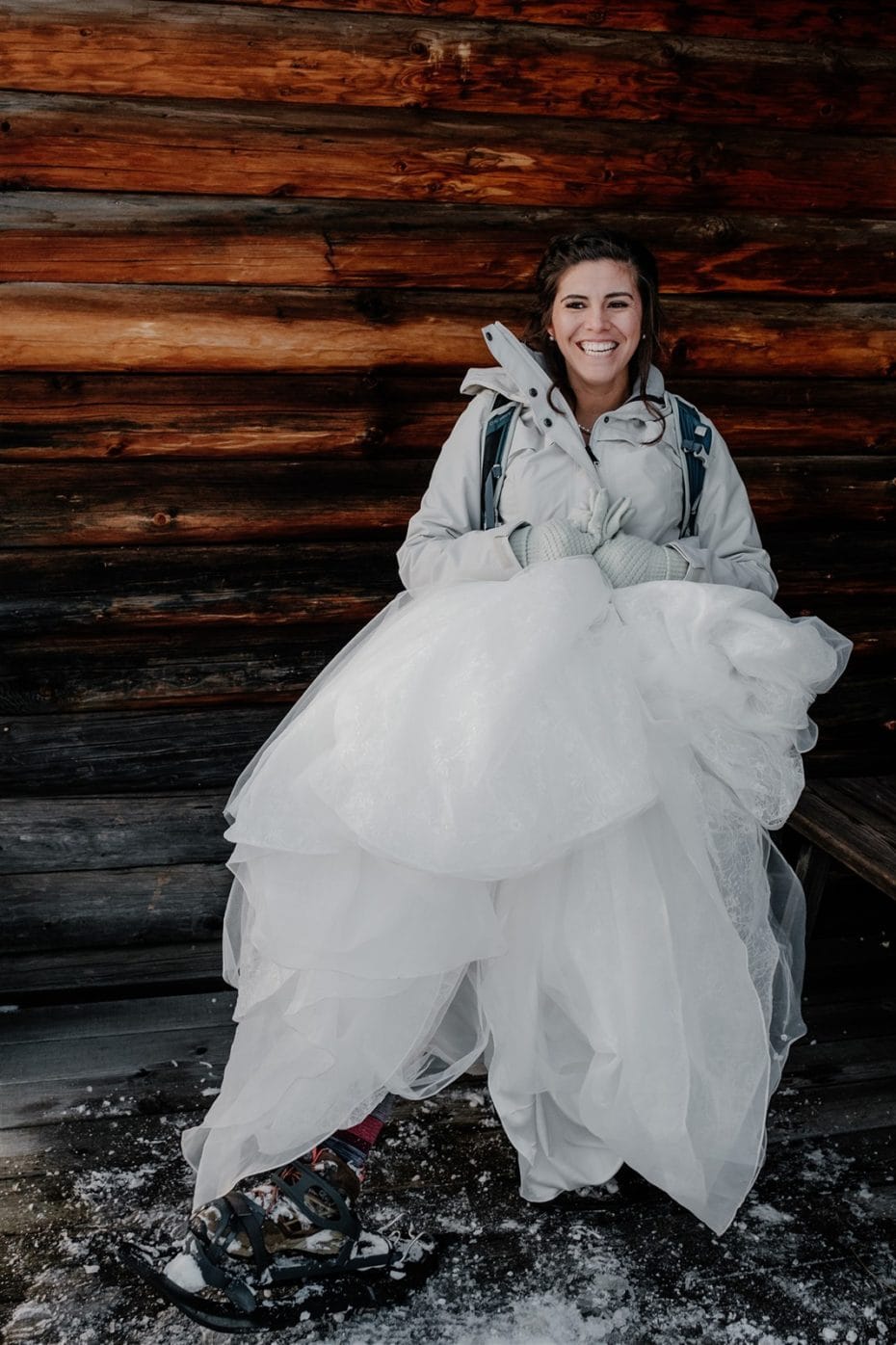
Winter Boots
I wanted to mention winter boots separately, as there are so many winter boots on the market right now, but many are unsuitable for anything outside of walking from your chalet to the apres ski bar. While I am a big fan of winter boots like Sorels, they have their time and place. If you are doing any form of hiking in the snow, even just a short walk to a viewpoint after taking up a lift, then you’ll still want a hiking boot over a winter snow boot. Most winter boots are designed to keep your feet warm but are not designed with great tread underneath or give you much stability around the ankle. It’s better to wear hiking boots with a deep tread and put some thick socks on, as you’re much less likely to slip. And if you’re planning to snowshoe, hiking boots are also the best option for footwear inside the snowshoe binding.
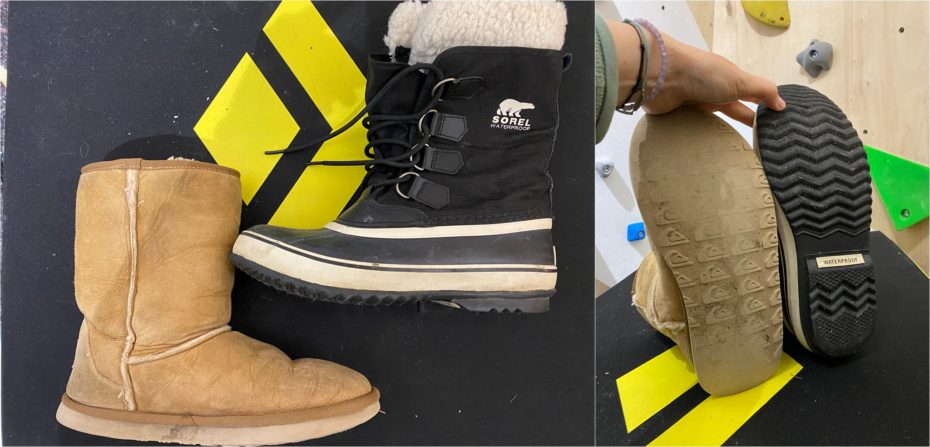
Some Hiking Boot Inspiration
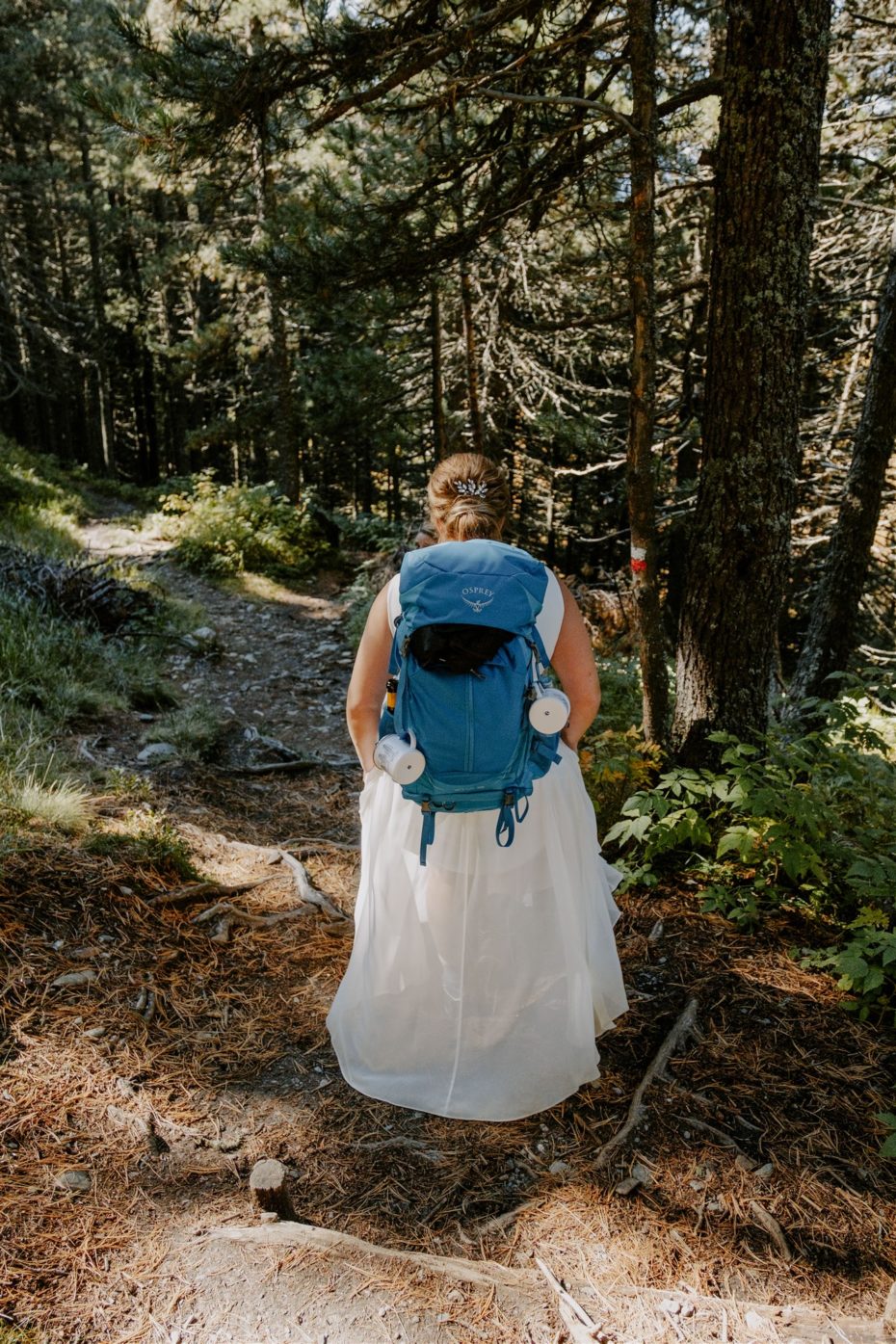
Choosing A Backpack For Your Adventure Elopement
A good backpack can make the difference between an incredible time, and a really terrible one. If you’ve ever tried hiking with a badly fitting backpack, or one where you haven’t quite been able to fit everything in then you’ll know what I mean. When choosing one for your elopement think about size, fit, the straps and the back support:
Size
The size of backpack you need will depend on the time of year you go, how far you are planning to hike and whether you are going on a single day or multi day trip. Generally for hiking elopements for single days I recommend a 15-25L day pack and for multi-day elopements, a larger 30-50 litre backpack to carry your overnight gear and extra items.
Depending on your route you might need extra gear with you, like axes and crampons, or climbing equipment if so you’ll want to make sure you have a back pack that is large enough, but that also has the right compartments, pockets or straps for the gear you want to carry.
Fit
Just like footwear ensuring your backpack fits before your elopement is essential. It’s a good idea to try it on, fully packed, with the clothing you are planning to hike in – especially if thats wedding wear – to make sure that it fits snugly and doesn’t rub anywhere. There are lots of guides out there to help you fit your backpack properly, and you may be able to find information for your make and model of backpack. As a general guide you’ll want to start by making sure that the hip strap sits on or above the top of your hip bone, then adjust the shoulder straps accordingly.
Padding, Suspension System and Straps
When choosing your elopement backpack you’ll want to make sure you pick one that has an internal frame suspension system, padded adjustable shoulder straps and a padded waist strap as a minimum. This is really important to make sure that the weight of what you are carrying is distributed across your hips rather than pulling on your shoulders.
A sternum strap can also be really useful and is common on most hiking backpacks. It helps to make sure that the shoulder straps don’t move apart as you walk which is particularly helpful on longer more adventurous trails.
Some backpacks, especially those for longer distance hiking, will also have Load Stabilising Straps on the shoulders and waist band. These help to bring the weight closer to the body and keep it stable as you hike.
A lot of hiking backpacks now also have ventilated mesh backs to help you stay cooler as you are hiking and reduce perspiration. This isn’t an essential feature but it can help you to feel more comfortable as you are hiking.
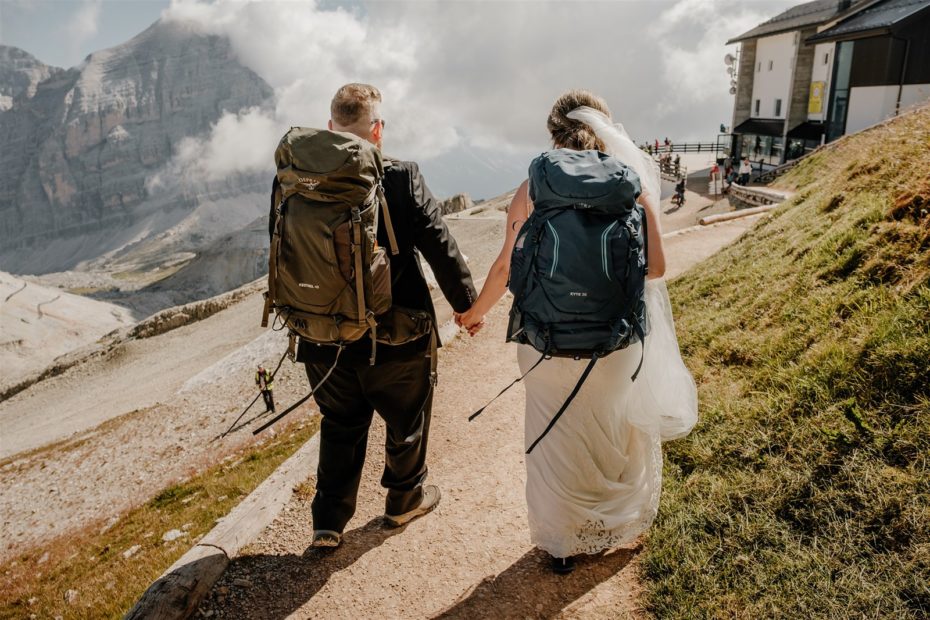
Should You Hike In Your Wedding Clothes?
Whether you hike in your wedding clothes will come down to a few variables, such as:
- Route length
- Terrain difficulty
- Weather conditions
For shorter and easier hikes, it certainly can make for lovely photos when you’re hiking in your wedding gear already. But if you’re worried about sweating too much, or we have a longer distance or more challenging terrain cover, then you may want to pack them and do a quick change when we get closer to the top.
If you are changing mid-hike, you might be lucky that there’s a nearby mountain hut with restrooms that you can use to change, but in some cases, it can be a matter of changing out in the open. If that’s the case, when you’re choosing your wedding clothes (mainly when if it’s a dress), think about the underwear situation, and also how easy it will be to get on/off when you’re attempting a quick change on a mountain top. Bringing a large travel towel that someone can hold up as a “modesty curtain” can be an option, but it is also one extra thing to carry. If you’re working with me on your elopement, I’ll help you decide what’s the best way to do it.
When you are choosing your clothing, your outfits should be something you can:
- Easily move in (try raising your legs, taking big strides, lifting your arms up etc)
- Isn’t going to catch easily
- Is comfortable
- Is easy to change into/out of
If you’re looking for outfit inspiration, don’t miss these other posts:
– Sustainable Wedding Wear
– Elopement Dresses You Can Buy Online
– Gender Neutral Wedding Wear
– Bridal Jumpsuits
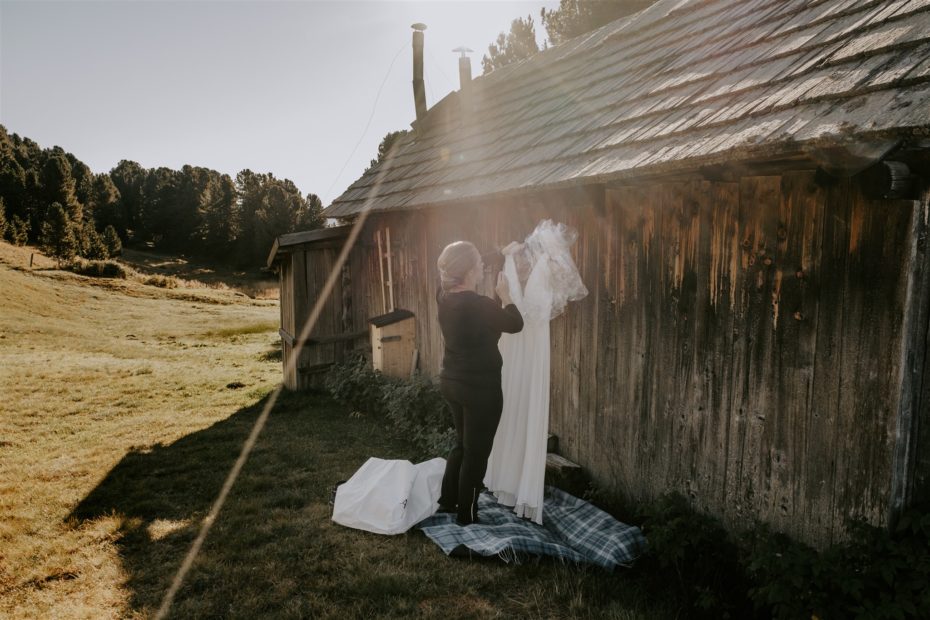
To Bustle or Not To Bustle?
For hiking elopements, if you pick a dress with a train (they do look dramatic), then I do recommend getting a bustle put into the dress if it doesn’t have one. There will be times when you are just hiking and we’re not taking photos, and having the dress away from the floor and having your hands free can make things so much easier. An alternative is to pull the dress up and tuck it into the waistband of your backpack or a belt so that the hem is off the floor.
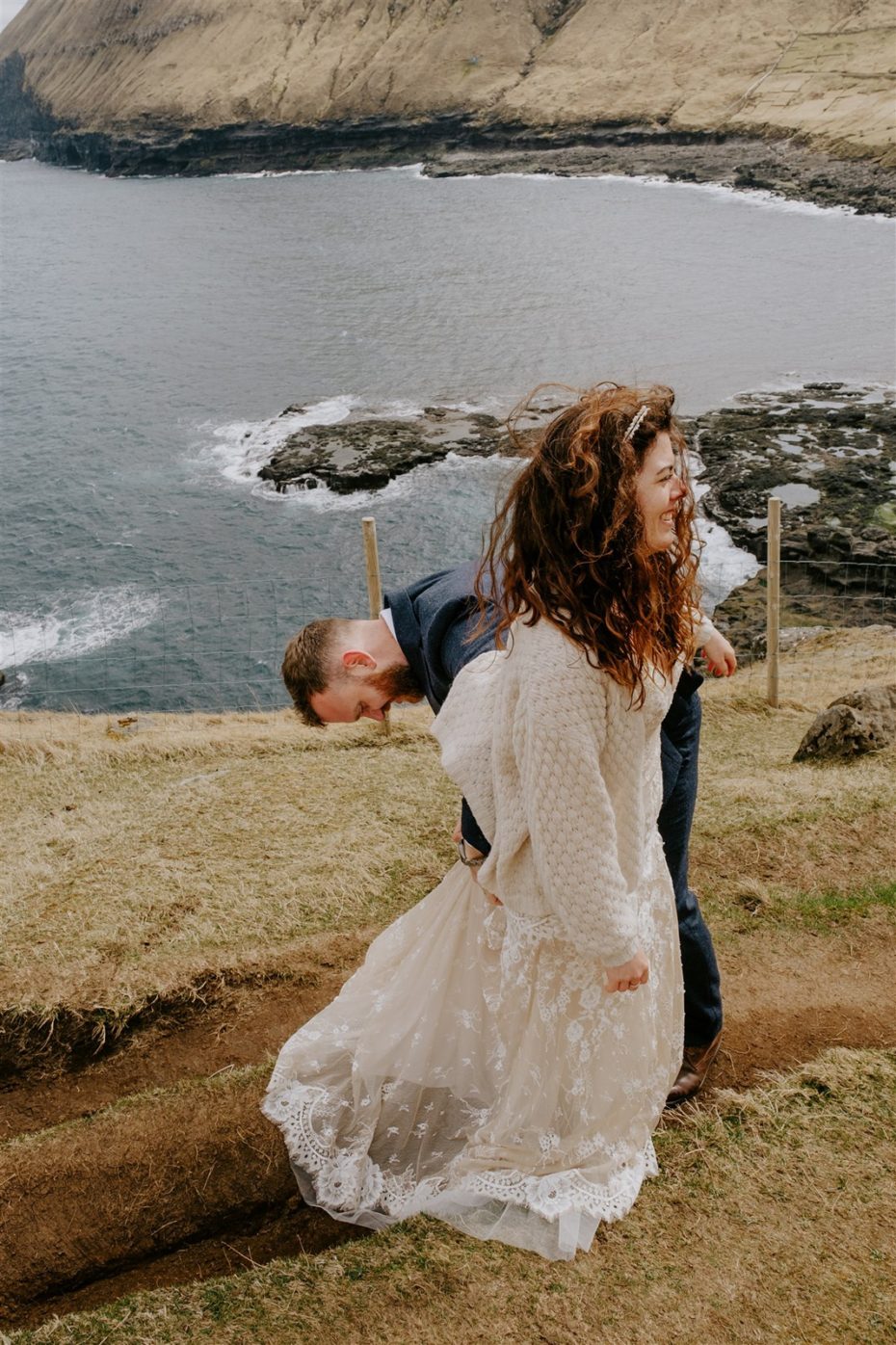
Got any more questions? Leave a comment below this post or if you’re one of my couples, email me or book a catchup call to chat things over.
Related Reading

